






LEARN MORE...


WE STRIVE FOR NOTHING LESS THAN CUSTOMERS FOR LIFE.






FREE OVERNIGHT CAMPING AT 1000+ UNIQUE
DESTINATIONS
We are a network of wineries, breweries, distilleries, farms, and attractions that invite RVers to stay in 1000+ stunning camping sites. The $79 yearly membership gives members unlimited access to stay overnight at any one of our Host‘s locations. We kindly ask our members to support their Hosts by purchasing one of their local products with each stay.
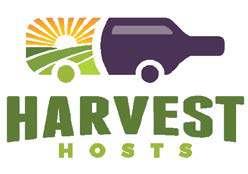




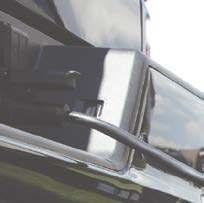


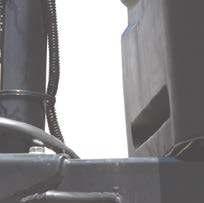

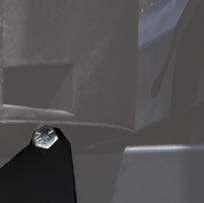

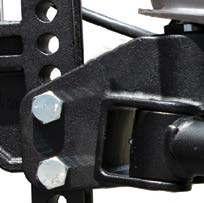


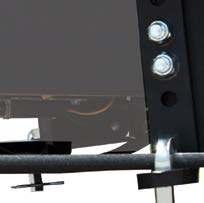


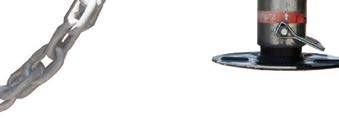



 Caster in the hitch head constantly brings the trailer to the center of the tow vehicle.
Caster in the hitch head constantly brings the trailer to the center of the tow vehicle.





When you’re the four-legged adventure king of Instagram, no ordinary dog house will do. Loki the Wolfdog and his human, Kelly Lund, spent years searching for the perfect setup for their lengthier journeys. They spent a lot less time finding a way to power it. Over 300 Ah of Battle Born Batteries on board are more than enough energy for all the hammock naps and alpine paddleboarding they’ll be sharing with their 2 million followers. With power like this, they’re turning the adventure of a lifetime into a lifetime of adventure.


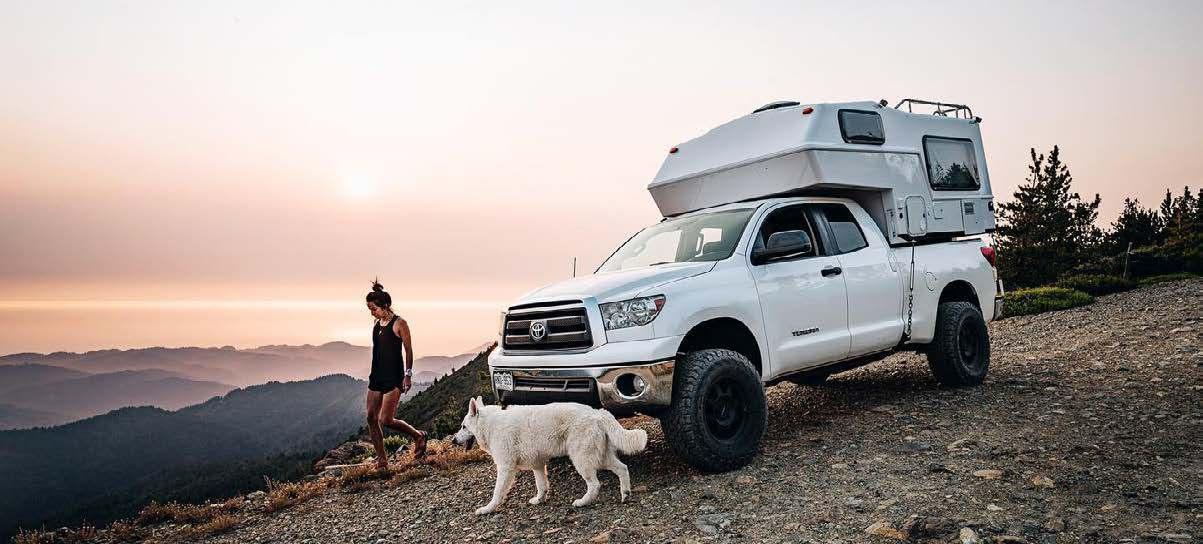
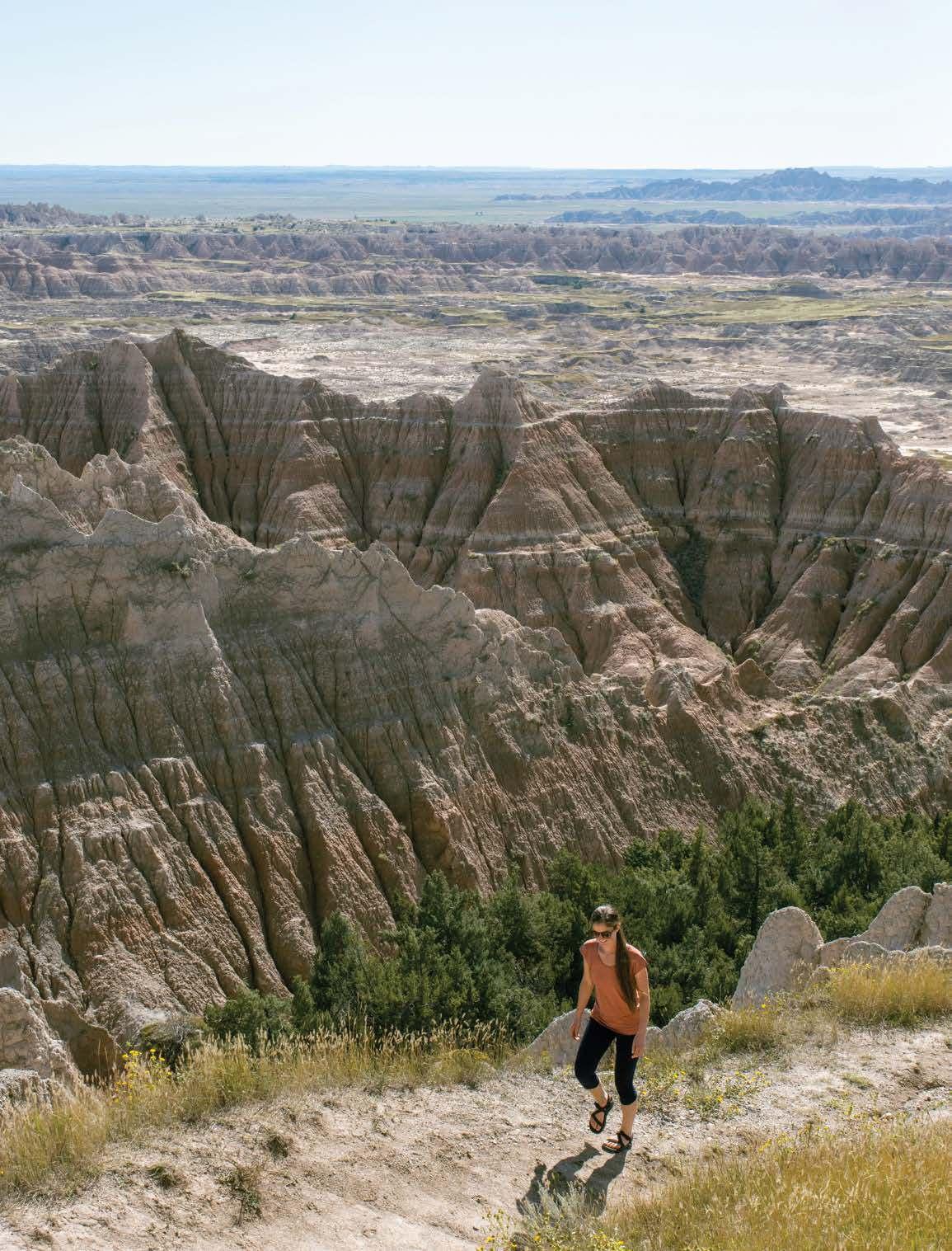


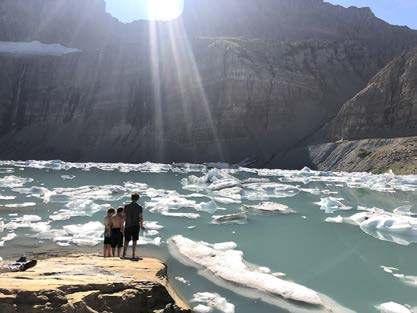




Page 13 | From the Founders
Page 15 | The Feed
Page 17 | Saving Money on the Road
Page 23 | Fifth Wheel Facelift
Page 27 | Baby On Board Surviving Full-Time Travel While Pregnant
Page 31 | Tips for Buying Your First RV
Page 33 | The Greatest Adventure on Wheels Planning Elopements on the Road
Page 37 | Solo Vanlife From Corporate Drudgery to Fulfilled Living
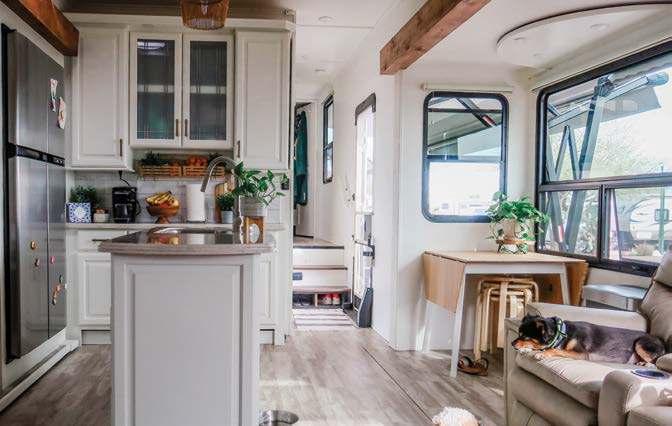

Page 41 | Earn Money On The Road Teaching English with VIPKID
Page 46 | Finding Freedom at Fifty
Page 50 | Will Work For Travel Providing Disaster Relief

Page 54 | Create a Business on the Road Turn Your Passions Into Income
Page 58 | Writing a Mystery Murder Book
Page 61 | Joshua Tree National Park A 2021 Bucket List Park
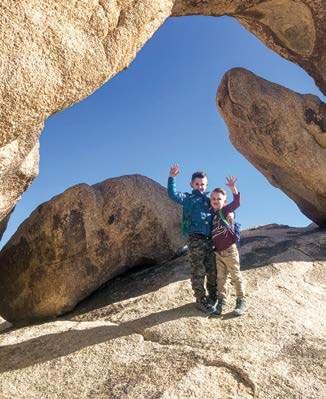
Page 66 | Idaho’s Sawtooth Mountains
Travel Guide From Adventures of A+K
Page 73 | A to Zee Across America
300,000 Miles, 3 Rules, 1 Epic Road Trip
Page 78 | Badlands National Park Why South Dakota Is Worth The Trip
Page 82 | Boondocking Sublett Reservoir, Idaho
Page 84 | Gear Guide
Contributors For Digital Nomads, By Digital Nomads
Page 86 |
Page 87 | Podcasts for the Drive

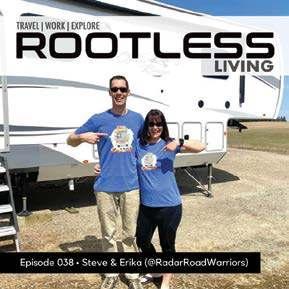
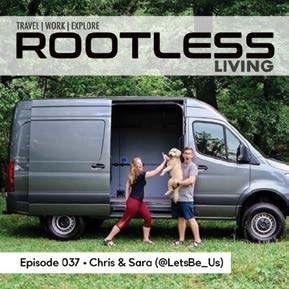

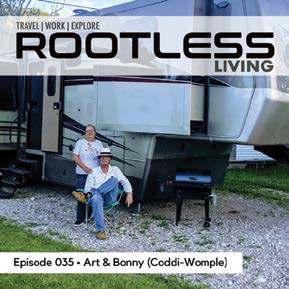


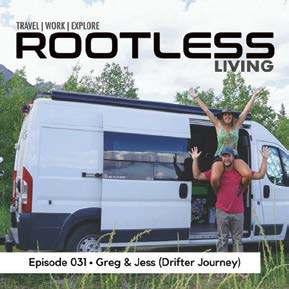







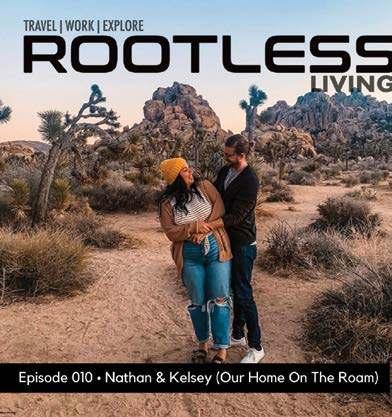

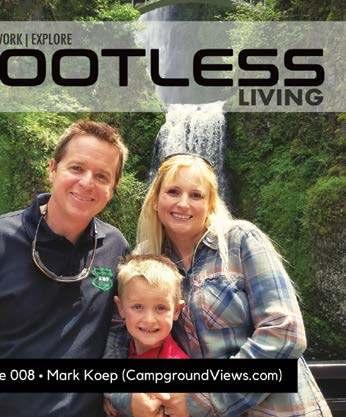
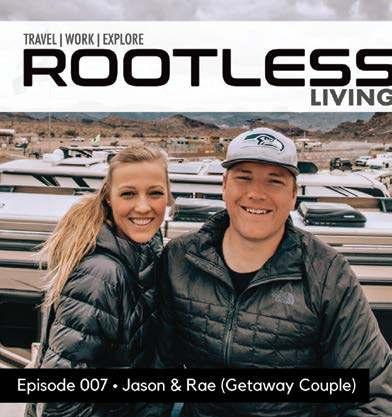
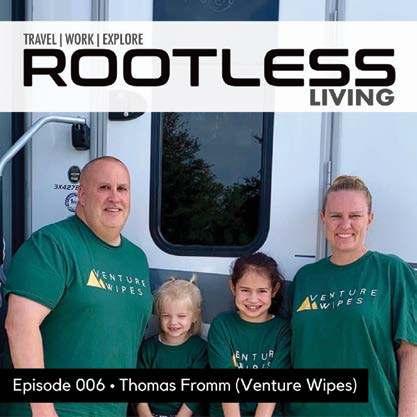

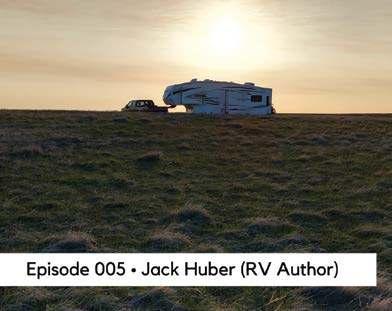
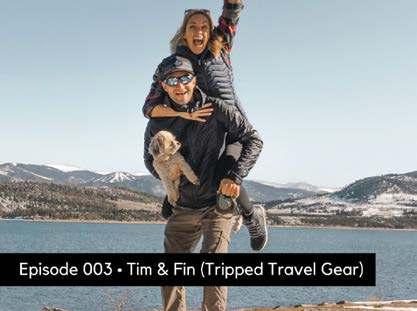

When we started the magazine in January of 2020 we had themes for each issue, which really helped when launching a brand-new magazine. It defined for our readers what to expect and helped direct our contributors in their writing.
For the past few issues, however, we started to let the content lead the way. And that is how the issue you now hold in your hands came to be “The Adventure Issue”.
If you are thinking about becoming a digital nomad, or already are one, you are setting yourself up for the adventure of a lifetime. The adventure of finding or creating a way to earn money while you travel, then buying and planning your transportation. And, of course, the adventures in exploring new places, meeting new people, and enjoying your life to the fullest.
In this issue we are excited to bring you different ways people have transitioned their lifestyles and careers to take advantage of remote working. From creating a business from your passions, to teaching English, traveling for work and sports, to writing a novel.
Up for an adventure to a new State or National Park? From California to South Dakota and every state from A to Zee, in this issue members of the Rootless Living community are sharing all their favorite places to explore.

Our founding mantra is “For Digital Nomads, By Digital Nomads” and we will continue to share your stories, tips, passions, and experiences on this adventure filled life. In the magazine, on the podcast and in our social media accounts, we’re here to help tell your story and inspire others who may just see themselves in your journey.
Until the next issue … stay Rootless.
Demian Ross Publisher demian@rootlessliving.com
Nikki Kirk Editor
nikki@rootlessliving.com
demian@rootlessliving.com
Nikki Kirk Editor
nikki@rootlessliving.com




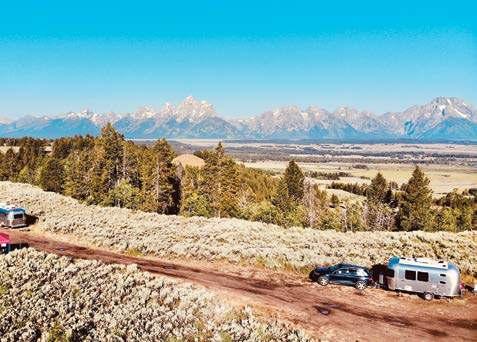
“So happy to see something like this for us full-timers. Today was my 2nd anniversary living the dream.” - Kathleen
@Life_Enroute
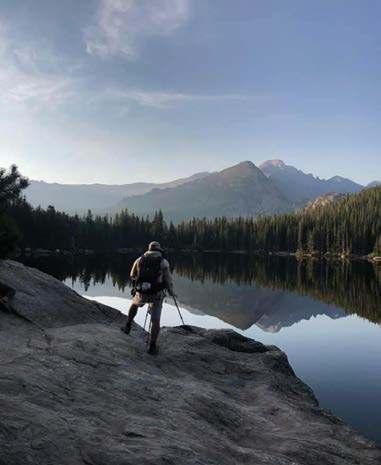
“Difficult roads often lead to beautiful destinations. Another lovely spot that we probably wouldn’t have attempted to get to with our fifth wheel.”

“The best part about traveling is experiencing a place for the first time.”
“Ready
change
scenery in 2021.”
“Living in a small space is all about organization, planning, and knowing yourself. Prioritize you and the way you want to live.”




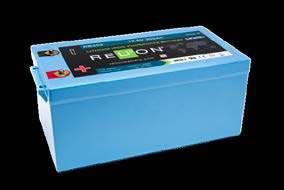

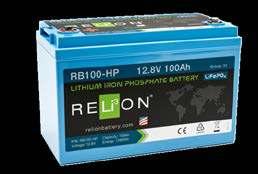

In nearly three years of living and traveling full-time in our self-converted skoolie, my boyfriend Aaron and I have learned quite a few ways to save money while still maintaining a standard of living (and cleanliness) that allows us to occasionally enter mainstream society without raising eyebrows.

Driven by a desire to ditch our 9-5s and the mountain of bills that comes with living in a trendy Seattle neighborhood, we bought a school bus in 2017, converted it over the next eight months, hit the road in April 2018, and haven’t looked back since.
Don’t pay for camping. Especially in the western half of the country. There is a wealth of free camping locations ranging from empty patches of desert to organized campgrounds that include bathrooms, picnic tables, and fire rings. The cost of paid campgrounds and RV parks ranges from roughly $10 to $80 per night, so after three years (1,095 nights) of free camping, we have saved somewhere between $10,950 and $87,600. To put that into perspective, we paid about $50,000 for three years’ rent in Seattle.
Of course, boondocking and staying at most free campgrounds requires that you have a self-contained rig, which is why we invested in a solar energy system, a composting toilet, and a basic plumbing system for our sink which also doubles as an outdoor shower. These elements provide most of the benefits that would be gained from staying at a paid park, and we don’t have to deal with noisy neighbors just feet away from us. Plus, we have stayed in some absolutely incredible free locations that are arguably just as scenic (if not more so) than paid camping areas.
We find our free camping spots by using resources like freecampsites. net, Campendium, iOverlander, and Google Maps. Unless signage indicates otherwise, most U.S. Forest Service and Bureau of Land Management land allows for 14 days of free dispersed camping. Always be sure to follow Leave No Trace principles when boondocking on public land.
While not technically free, programs like Boondockers Welcome and Harvest Hosts can also provide good low-cost options. Both programs charge a yearly subscription fee, but
once the annual fee is paid all camping is free. However, Harvest Hosts suggests that you spend around $20 at each host location, rendering it actually relatively expensive if you do so.

Take advantage of free water whenever you can. Many freeway rest stops (especially in the Pacific Northwest) have free dumping stations and clean water stations, which is a huge bonus since many dump and fill stations cost between $10 and $25 per visit. A Google search of rest stops near you can reveal free stations near your location. We always fill every water tank and container we have when we find one of these gems!
Many gas stations in the Southwest also have free dump stations on-site. Although the water there is sometimes labeled as non-potable or not labeled at all, it is usually the same water that comes out of the tap in the gas station building. Because of its proximity to the dump station, they can’t legally label it as potable.
In a pinch, we have hooked up our inline water filter and filled our tanks this way. We haven’t gotten sick or died yet, but use this method at your own risk. We have also taken our seven-gallon water jug inside gas stations and filled it using a funnel at the soda machine water dispenser, then filled our built-in 21-gallon fresh water tank from that. This is somewhat laborious and timeconsuming, but it works.
Some campgrounds will also allow you to fill your water
tanks for free even if you aren’t staying there. KOAs are particularly generous with this, but call ahead to make sure the one near you offers this service. Many national parks also have free dump/fill stations, especially if they have campgrounds. We usually have an annual national parks pass and visit parks frequently to hike and see the sights, so we count this as free water.
When there’s no free water to be had (ahem, most of Arizona), we take two seven-gallon jugs into Walmart locations when we grocery shop and fill them at the purified water stations for 29 cents per gallon. These water fill stations can be found at many different locations and range in price from roughly 15 to 40 cents per gallon. It does require some extra effort to then dump the water into our fill hatch to replenish our builtin tank, similar to the gas station method. However, this way we don’t have to make an extra stop, and we can get our water for the week for less than $5.
Never stop at the first gas station in town. Our bus has a 55-gallon diesel tank which is amazing when we can go around 600 miles without refilling, but it can really put a dent in our wallets when the time comes to fuel up. We occasionally use the GasBuddy app to find the cheapest diesel nearby, but we have some trust issues with that app after it directed us to a gas station in downtown San Francisco on a Friday night during rush hour that didn’t actually turn out to sell diesel at all, leaving us running on fumes.
As a rule of thumb, we never stop at the first gas station that we come to, especially after a long stretch with no services. We learned once the hard way that these stations levy a convenience fee, sometimes charging up to 40 cents more per gallon than another gas station mere blocks away. With our massive tank, that’s roughly a $20 difference.
On a similar note, we always try to avoid purchasing fuel in California whenever possible, because the prices there are always much higher than the surrounding states.
Finally, we always fill up before heading into an area with few services such as national parks or unpopulated areas. We once saw diesel going for $6 per gallon in Death Valley!

Opt for free entertainment. One of the biggest things that helps us save money on the road is that we switched to mostly-free entertainment options as opposed to frequently going out in Seattle. We estimate that we used to spend roughly $400 a month just going out for drinks or dinner, $160 a month on climbing gym memberships (which serves as both a fitness and a social activity for us), and $200 a month on extraneous things like cable, various subscriptions, clothes, haircuts, and going to movies or shows.
While on the road, we spend maybe $50 a month visiting local breweries (pre-COVID-19, obviously) and
otherwise choose free entertainment options like hiking, outdoor climbing, paddleboarding, hanging out with friends we meet on the road, watching movies, or playing games. This not only saves us money but is also much healthier.
Sign up for free health insurance if you are eligible. One of the best parts of living on the road is having to work much less since we have relatively few bills and expenses. As a convenient result, while we live comfortably off our part-time freelancing incomes, we technically fall below the federal poverty line which makes us eligible for free health insurance through the Affordable Care Act and Medicaid. With the average cost of a private health insurance plan at somewhere around $450 per person per month, this is a huge savings for us. Additionally, it gives us some peace of mind in case of injury or illness, and we don’t have to pay the penalty for not having coverage.
Shop based on your location and the season, and buy in bulk when you can. One of my favorite foods is avocados, which range dramatically in price and quality based on where we are located. It can cost upwards of $1.50 per small avocado in the Pacific Northwest and usually at least one out of the handful that I select will not be good, whereas I’ve found them for 33 cents apiece in Walmarts in the Southwest and never gotten a bad one.
Previous to buslife, we would buy whatever groceries we felt like eating, mostly regardless of the price. Now, however, we pay much closer attentiontothepricesofthingsandwhatwillkeep for a decent period of time in our non-climatecontrolled bus with very limited refrigeration space. For instance, we learned quickly that bread products and bananas were a no-go in the humid Austin heat. We are much more careful selecting foods that fit our location and season, which saves us money at the store and prevents us from wasting food that spoils.
Finally, while storage space is obviously limited, we do stock up on certain things at Costco when we happen upon one, because the bargains are just too good. We mostly opt for shelf-stable items that we use frequently like quinoa, chicken stock, cans of LaCroix, and the obscenely-large bags of Boom Chicka Pop that are only available at Costco.
Thecostoflivingontheroadcanvarydramatically from person to person depending on one’s standard of living, but by following a few of our tips, we’re confident you’ll be able to cut your finances where it makes sense for you. Being a digital nomad is all about having the freedom to live your life more intentionally — and by being intentional with your finances, you’ll be happier on your journey.
Cat is originally from Seattle, WA but has traveled around the U.S. and Canada full-time in a selfconverted skoolie with her boyfriend Aaron since April of 2018. She enjoys rock climbing, paddleboarding, hiking, and generally being outdoors! You can follow her adventures on Instagram at @stu.the.bus.
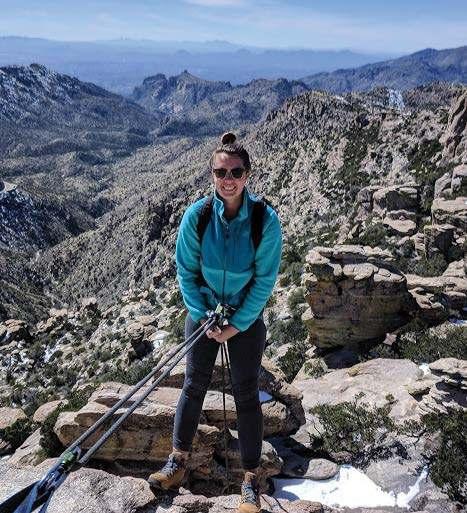

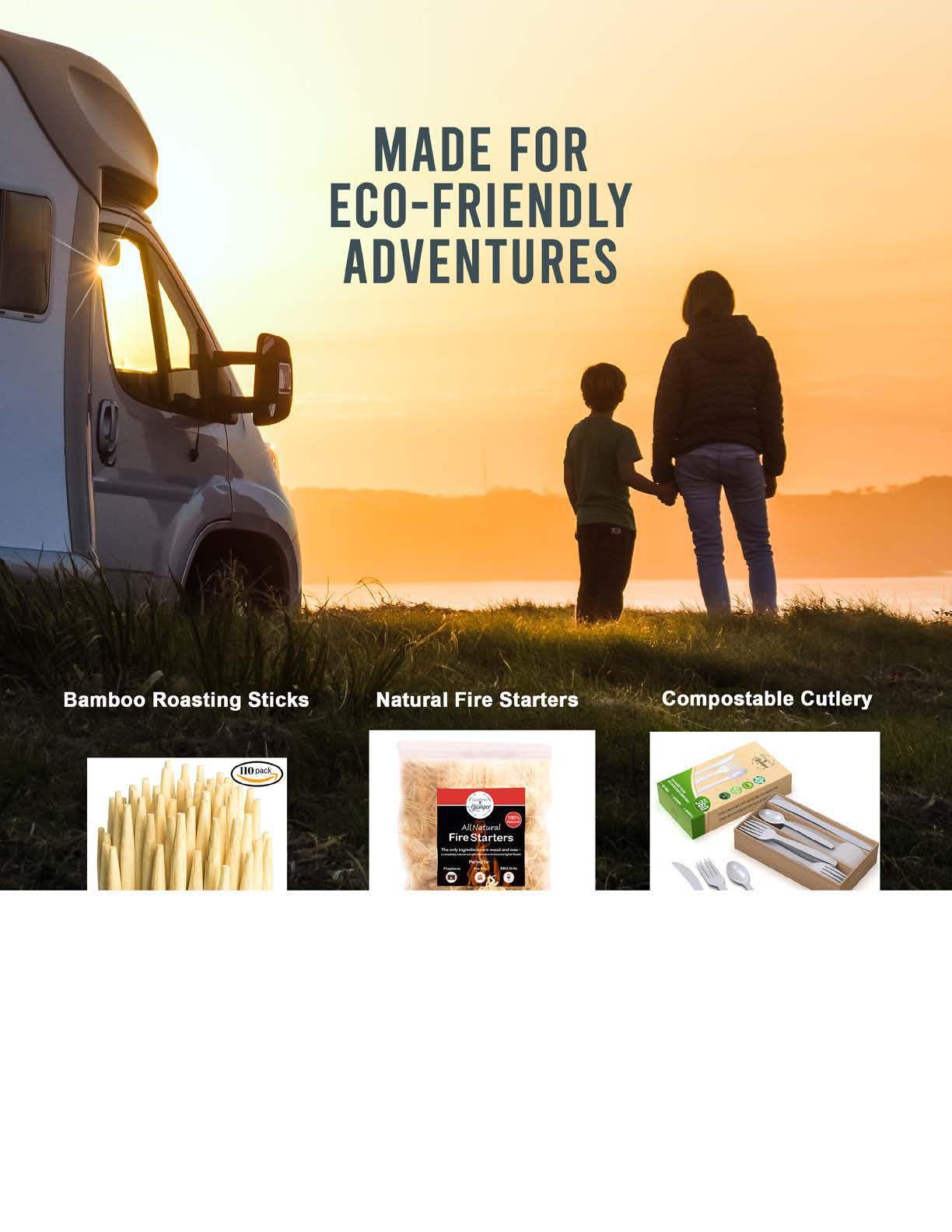

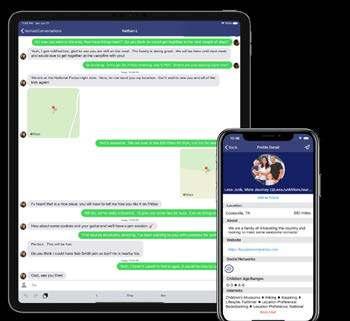
Download Today!


Nomad Near Me connects you with friends you know as well as friends you haven’t met yet.




We are the Gossetts. My husband Daniel and I, along with our daughter Lucy, live in a 2020 Grand Design Solitude 377MBS fifth wheel with our two dogs, George and Huck.
We have painted, renovated, and fully settled into our new camper, but our RV story didn’t start with this fifth wheel — it started with another one back in 2018.
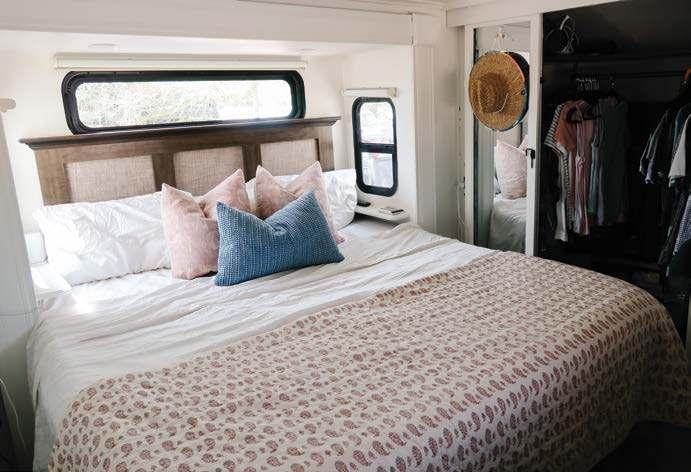
Myhusbandplaysprofessionalbaseballand at the beginning of our baseball journey, we found ourselves traveling ... A LOT. After purchasing our first home, we split our time between our 3 bed/2 bath house in our hometown of Lyman, South Carolina and our Grand Design 297RSTS travel trailer in Arizona during spring training. Add in our time in Nashville with the Oakland A’s Triple A team, and you could officially say we were living out of boxes with one foot in a traditional home and the other in the RV community.
You might be wondering (like many of our friends and family at the time) how we came about living in a camper while my husband was playing baseball. Well, why not? We were both young, no children, and felt moving from rental to rental to back to our house in South Carolina wasn’t a sustainable way of life. Although, I do have to admit, I thought my husband was crazy when he first pitched the idea of me moving across the country with him to live in a camper. But like many of you surely know, once I got a taste of the RV life, I fell in love with the lifestyle, community, and freedom. It only took a few months of RVing for us to come up with a crazy idea: let’s go full-time in the RV.
In 2018, we made the decision to sell our home, buy a fifth wheel, and pull our home from city to city. 2018 also brought the biggest blessing and life change: our daughter, Lucy.

With so much changing, I knew I wanted our new RV to feel like home, but to be honest I had no idea how to accomplish that! I had never set foot in a camper before our travel trailer much less lived in one fulltime! So, like any young person, I turned to the internet for answers and inspiration. I immediately found a community of fulltime RV families with beautiful, custom
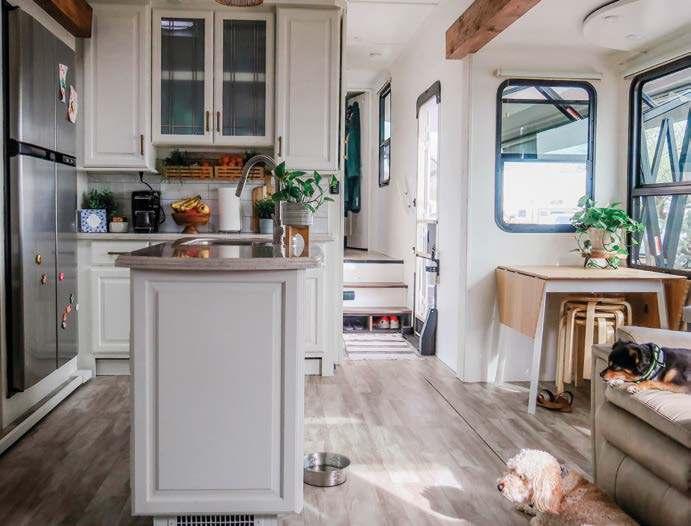
RVs that looked more like 5-star hotels than the traditional campers: all-white kitchens, beautifully decorated kids’ rooms, and a kingsize bed in the main bedroom. Needless to say, I got excited about the possibility of what our new RV home could look like.
When we ordered our fifth wheel from Grand Design, I knew the first step was to brighten it up by painting everything — and I do mean everything!Wepaintedallofthewalls,doorsand the ceilings Simply White by Benjamin Moore and the cabinets Swiss Coffee by Benjamin Moore and Grays Harbor by Sherwin Williams. Daniel and I painted non-stop for 3 days before we finally called it quits and hired a painter to finish up the cabinets and ceilings. While the painters finished up, we jumped back into renovations by constructing two hollow cedar beams that run the length of our living room and kitchen. The natural wood warms the space and was the “finishing touch” of the renovation that really made our RV feel like home. After just two weeks of painting and hanging beams, we officially moved in!
After a few weeks in the RV, we replaced a few furniture pieces to fit our lifestyle better. We switched out the dresser in our main bedroom and added a smaller and more-sleek kitchen table. I also went on a long search for our kitchen pendants — it would amaze you at all the options, but I love how the entire space came together. I also turned our second bedroom into our daughter’s nursery by taking out the couch and adding her full-sized crib. She now also has her own play table and room for all her stuffed animals.
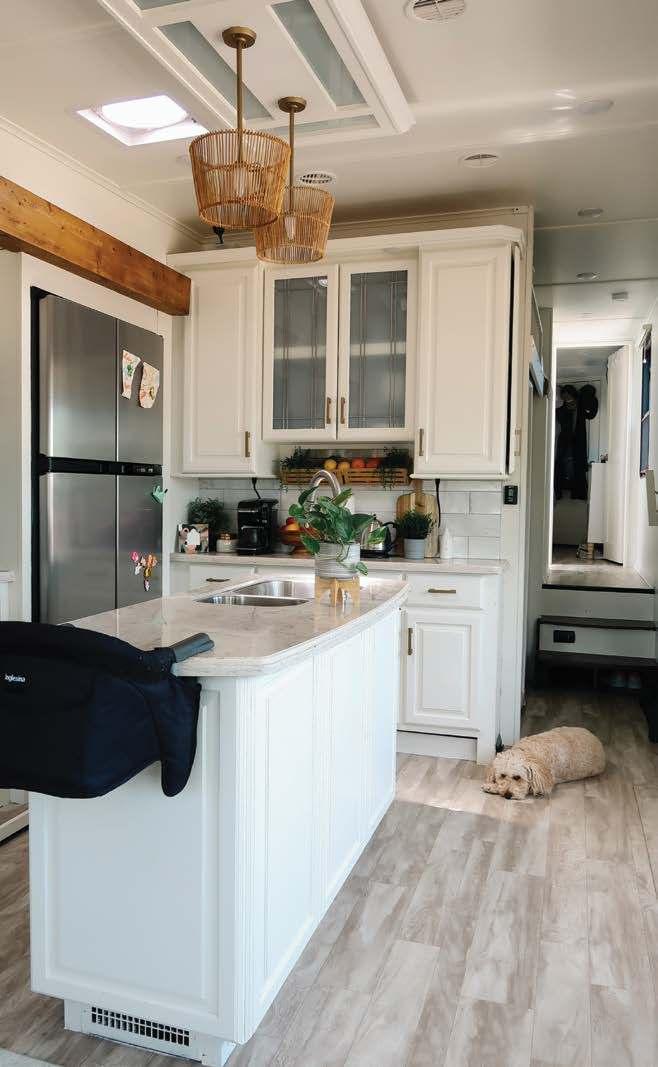
Much of our renovation was just paint. It’s amazing what a coat (or 12) of paint can do. I’ve even changed up the color of our island since our original renovation and love how different our home feels with each new color. We eventually want to switch out the island countertops and the kitchen sink, but that will have to wait until next offseason. We are currently packing up and heading to Florida for spring training for our fourth season with the RV. We are so thankful that no matter where baseball sends us, our home comes with us. We look forward to continuing our RV life well into our post-baseball life when we can downsize into something smaller and actually choose our destinations. After all, our travel bucket list keeps growing and growing.
Follow Presley, Daniel & Lucy on their full-time adventure on Instagram @presgossett
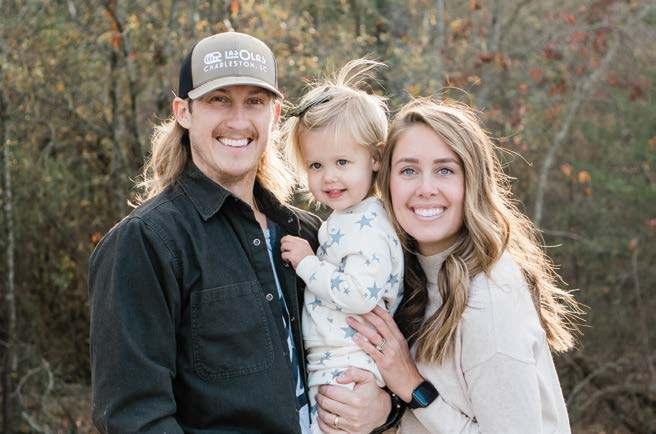

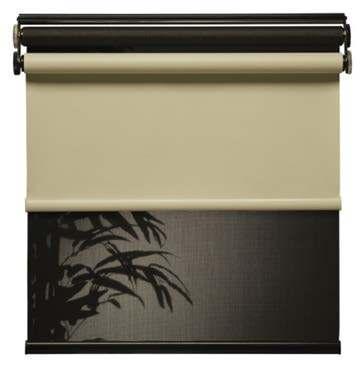

 By Jamie Rea
By Jamie Rea
We started discussing full-time travel in 2016 since Jerry worked remotely as an actuary for a health insurance company. We moved out of our house, turned it into a rental property and moved into an apartment to become more flexible as we prepared for a lifestyle change. We weren’t exactly sure what kind of travel we were planning for, but we knew we were excited to start our journey.
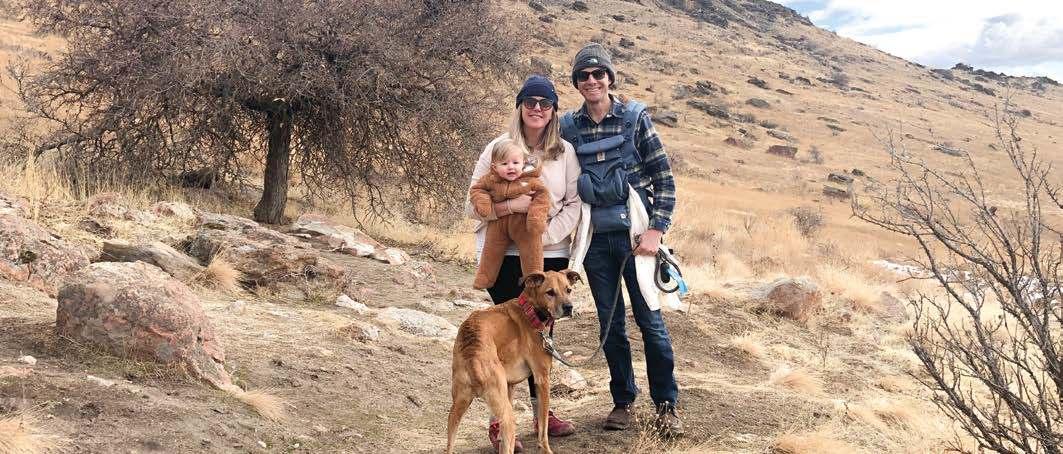
We first had the idea of extended travel in Europe but soon realized that would be way too difficult with our senior-aged dog. We then ventured down the path of traveling city to city and renting apartments on a short-term lease but didn’t like the idea of living out of our suitcases. At one point we even tossed around living on a boat but crossed that off the list fairly quickly.
When the idea of living and traveling the country in an RV was first discussed, we thought it was more attainable. However, we were both clueless on the lifestyle and had never stayed in an RV before. We started to spend hours and hours watching videos on YouTube and reading blogs. We didn’t even know anyone with a camper, so it was definitely a wild thought for us.
Realizing how many different types of RVs there are was very overwhelming, but we came to the conclusion that we loved everything about Airstreams. Locating the closest dealer, we found one that was about 4 hours away and drove there the following weekend to check them out. When we arrived at the dealership, we toured about 20 models and fell in love with them all, but then we found the model of our dreams and purchased the Airstream that day.
After purchasing our Airstream, our main problems were that we didn’t have a tow vehicle or place to park it. Thankfully the dealership was able to store it for us until we were ready to pick it up in 8 months. In the coming seasons we purchased our truck, downsized our wardrobes and personal belongings, and even sold or donated all of our furniture. It felt so rewarding letting go of so many material things as we

The month before we moved into our less-than-200-squarefoot space is when we found out we were expecting. Our family and friends began asking a lot of questions about how we would handle prenatal visits and live in such a tiny space with a newborn, but we knew we could do it.
Prior to hitting the road, I had already been to two prenatal appointments before we traveled all over New England during the first trimester. While we explored Maine, we found out that our little adventurer was a girl. Next, we headed back to Maryland for more prenatal appointments and worked our way south. By then I was approaching 30 weeks, and prenatal appointments would become more frequent. We realized we would need to stay put in one location and find a new obstetrician in Florida. Luckily enough we found a great doctor who also had lived and traveled full-time in a camper. What are the odds of that?!
Today, we have traveled to 25 states and are currently exploring the West with an almost one-year-old named Juliet.
What our typical travel day looks like We usually travel during the work week so that Jerry can work in the passenger seat while I drive and tow the Airstream. We try to hit the road after one of the baby’s feeding times and only drive a maximum of 4 hours with at least one stop to tend to any of the baby’s needs.
I do all the driving, parking and indoor set-up of the rig while Jerry handles the hitching, unhitching, and outdoor set-up. When we first started traveling full-time, we planned our destinations far in advance, but lately we have become last-minute planners. These days, we like to stay longer in places while Jerry works during the week as a digital nomad with an eastern time zone work day.
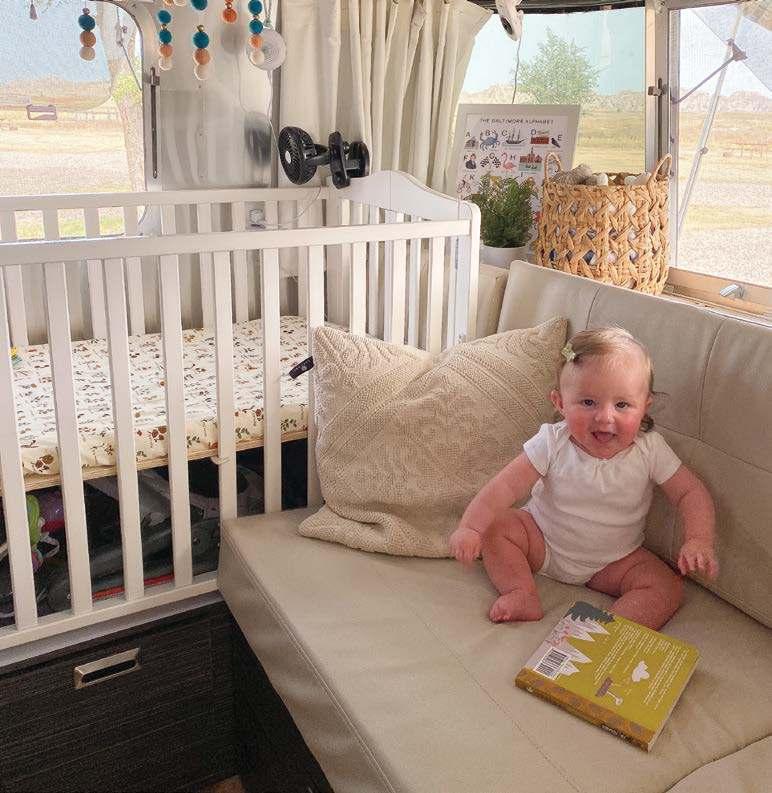
With only 18 inches of space on each side of our bed, we knew we would have to construct a safe sleeping area for the baby. Jerry was able to build a platform to fit right next to the bed, and we placed the bassinet on top and added little touches to create a “nursery nook.” We knew we had to keep baby items to a minimum and only bought the absolute essentials, like a good sound machine, a few outfits and a few toys.
Our biggest worry when we brought our one-day-old baby home to the Airstream would be that neighboring RV’ers would not appreciate a crying newborn. However, most of our neighbors never heard or didn’t know that we had a newborn. Whew!
When she was 8 days old we took her on her first road trip to another campground and stayed for 3 months so she could safely tolerate

being in a car seat for a longer period of time. Once she outgrewthebassinet,weplacedasmallcribonourL-shaped lounge that fit the space perfectly.
We were often asked how we would handle pediatrician appointments, which was also a concern for us as well. Fortunately, it has been quite easy to find pediatricians throughout our travels, and there have been no issues booking appointments. Our little traveler is completely upto-date on all her wellness checks and has been seen by pediatricians in Florida, Tennessee and Idaho thus far.
Life on the road with a little one has been so amazing, and we are truly loving every second of it. We are so grateful for this lifestyle and having our daughter with us to share it with. Since she is becoming more mobile, we are currently babyproofing the Airstream and converting the rear bedroom into a kids’ room!
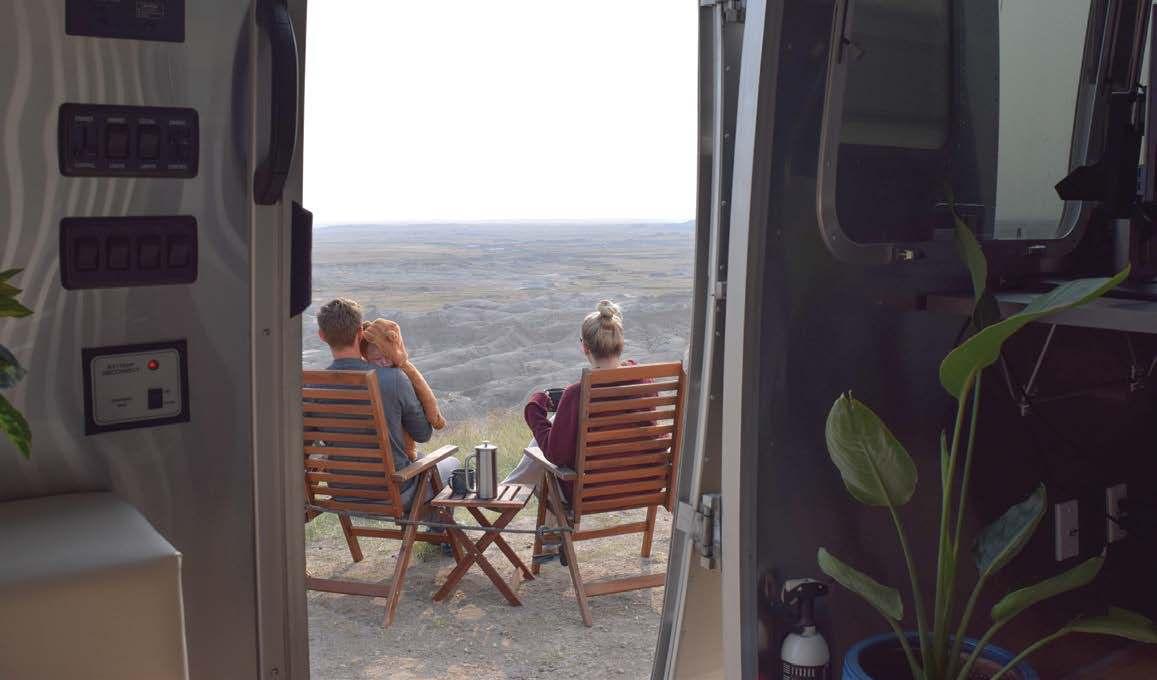
Our first rookie mistake when hitting the road was not having enough cash for tolls and not having an RV GPS. When we left the dealership and headed out on our adventure from New Jersey to Cape Cod, our truck GPS took us through New York City and the George Washington Bridge. It was a verynerve-wrackingtravelday,andmyneckandhandswere in so much pain from constantly checking my side mirrors and gripping the steering wheel so hard. I was terrified! Tolls during that drive cost over $200, and we barely had enough cash on hand to pay them.
We’ve had a few other slip-ups as we acclimated to the RV lifestyle. We were pulled over in upstate New York for driving on a passenger-car-only highway, which could have been prevented with a proper RV GPS. We also traveled during Labor Day weekend traffic, making a 4-5 hour trip take twice as long and causing us to arrive at our state park campsite in complete darkness. We’ve also experienced two blowouts in one day—one being Juliet’s diaper and the other being a tire on the Airstream.
In a way, our first trip really prepared us for life on the road after learning so much about towing, parking, and the inevitable complications of this lifestyle. But there’s nothing quite like full-time travel with the ones you love most, and you never know what kind of life is possible until you make it happen.
Jamie Rea grew up in Baltimore, Maryland and left the health field of occupational therapy for full-time travel but still is certified and licensed. She does all the towing and parking of the Airstream and is enjoying being a mother to her little nomad baby, Juliet. You can follow along Jamie, Jerry and Juliet’s adventure by following them on Instagram @Our_ReaLife.
Buying an RV is extremely exciting! Owning an RV means you get to visit unique places, try amazing food from all over the country, and check off bucket-list destinations. However, the buying process can be a stressful time. Once you begin your research, you find yourself asking important and hard questions. Should I go with a towable or drivable? What’s a good length for me? Do I need a special license? What floorplan is best for me or my family? Should I buy new or used?
These questions can be difficult to answer if you’ve never dipped your toes in the RV lifestyle. Don’t stress though, every RVer has been in your shoes at one point. When we were buying our first RV, we had no idea what we were doing. Now that we’ve been on the road since 2017, we’ve learned so much about the lifestyle and what we would have done differently when buying our RV. Here are my tips to get you thinking about important considerations when buying your first RV.
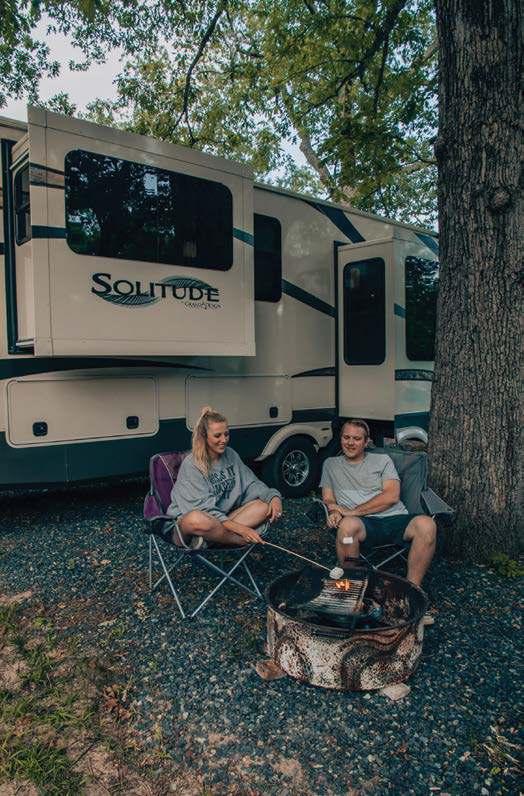
First, if you’ve never used an RV before, I highly recommend renting one. This is a great way to learn which floorplans you like and if you prefer driving or towing an RV. Not only that, but you get a feel for what the RV lifestyle looks like in regards to driving, cooking, showering, dumping your tanks, and so on. Renting can narrow down your preferences and help guide you to your perfect RV.
Once you’ve determined what type of RV and floorplan you want, your second step is figuring out if you want to buy new or used. There are pros and cons to both options, so

there isn’t a right or wrong answer here. Many things play into buying new or used including the availability of the floorplan you want, your budget, do you want to renovate, do you want to be the first owner, and so on. I recommend sitting down to write out the pros and cons that are personal to you for buying new versus used. Additionally, be sure to know your budget, as sometimes budget alone will put you in a used RV.
Speaking of knowing your budget, my third tip is factoring in other expenses when planning your RV purchase. Most folks only think about the cost of the RV and are surprised when they realize how much more they need to spend after the initial purchase. Be sure to include insurance, accessory costs, maintenance, gas, campground costs, and storage fees when you’re budgeting. These costs will fluctuate depending on if you will be full-time or part-time traveling, so consider how often you will be taking your RV out when thinking about this one.
The fourth tip is knowing when and where to shop for your RV. Buying an RV is not something you want to rush in to. Take your time visiting different dealerships in your area as well as knowing when the local and national RV shows will take place. Holiday weekends, RV shows, and the end of the year are great times to plan to buy your RV as dealerships are eager to get models off their lot. Make sure you compare prices from different dealerships and wait for sales. Buying an RV is not like buying a car, and there are plenty of negotiation tips available to you online. We have negotiation tips on our website, but a Google search should get you started in the right direction as well.

I hope you found these tips helpful. If you would like to learn more about the RV Buyers Bootcamp Signature Course, visit RVMasterclass.com. From the four in-depth seminars, you’ll learn how to pick out the best RV for you, learn tips and tricks for negotiating and financing, how to perform a handson Pre-Delivery Inspection, find friends on the road, and so much more. Hope to see you out there!
Rae Miller is a Co-Founder of RV Masterclass and one half of Getaway Couple. She and her husband, Jason hit the road in 2017 with their Doberman-mix, Carmen, and fell in love with the RV lifestyle. Their initial “one-year RV trip” now has no end in sight. When she’s not sharing RV tips and tricks online, she can be found hiking with her dog, or more realistically, beer tasting wherever the closest craft brewery is.

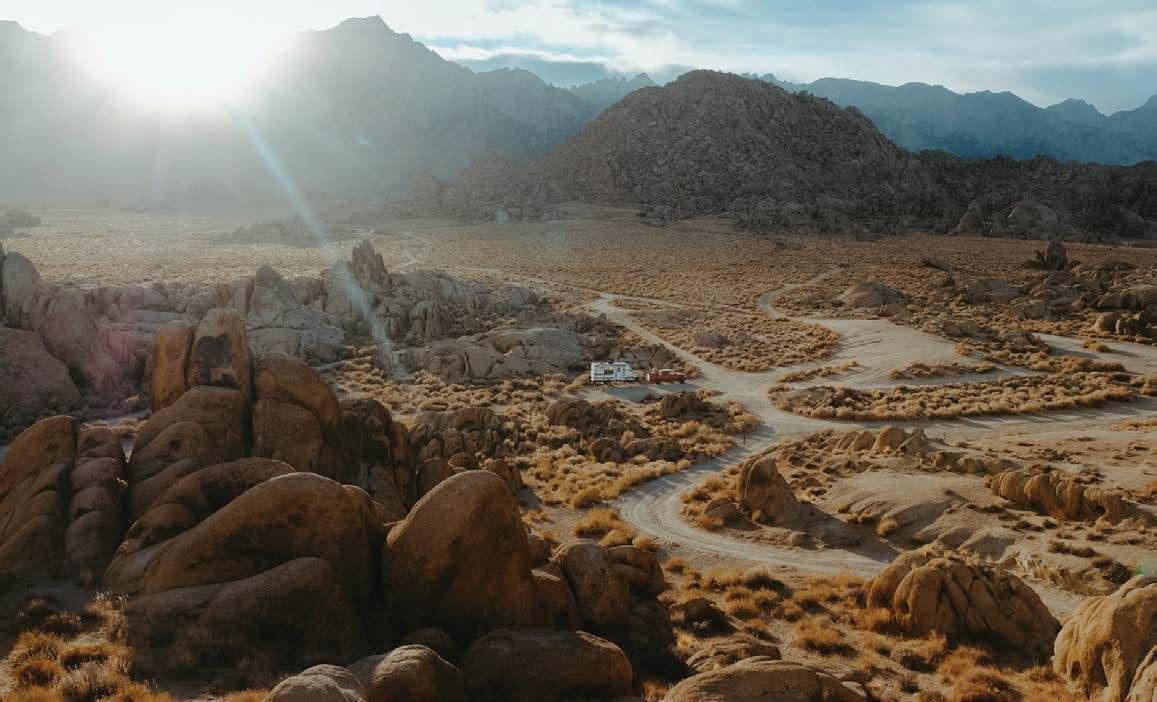
We are Erika, Ryan & Sage! Sage is a recent addition to the family — we weren’t planning on adopting a pup while on the road, but not much of 2020 has been expected!
Ryan and I are a husband & wife team, and we own The Greatest Adventure Weddings & Elopements. I started wedding planning back in 2015, but the big, traditional, ballroom weddings were never really my thing. About 4 years ago (right around the time Ryan and I began dating), I started seeing more and more photographers in the industry doing intimate, adventurous weddings, and I wanted in on the action! I saw this as my chance to merge my biggest passions: wedding planning, being outdoors and traveling. There really weren’t any other companies planning elopements at the time, so I wasn’t sure if anyone would be interested when I first started. Luckily, the service took off right away.
Ryan started working with me early on in our relationship, mostly because I was working on the weekends and traveling a lot so he wouldn’t have seen me much otherwise.
By Erika HernandezIt was just a bonus that he had a business and marketing background with experience in event planning as a banquet manager at a golf course. It wasn’t long before he told me he’d eventually like to work with me full-time.
Most guys would have been scared to even date a wedding planner, but Ryan likes to introduce himself as my associate planner. Like me, he loves that we get to travel, get outside (we hike, snowshoe, and kayak with our couples), be our own bosses, live our own schedule, work together, and bonus: Our job is to celebrate love!
I honestly never thought I would marry someone I could work with so well since I can be a little bossy. It took me a while to come around to the idea of being in business together, because while I love working with him, I never wanted to take away from his dreams & goals.
Ryan and I started adventuring right away after meeting. Our first big purchase together was an orange Marmot tent. We have always loved road tripping and camping, and I insisted
that one day we’d do “the vanlife/RV life thing.” Back then, he was more like “yeah, yeah, yeah,” because he was working a 9-5.
Fast forward to February 2020: We boarded a plane to Hawaii for our first elopement of the year. Everything was normal. We were excited for a big year, which included getting married ourselves! By the time we got home a week later, the world had changed. Long story short: COVID-19 sucks, but it gave us the last little push we needed to start our life on the road!
Ryan was furloughed from his job not long after we returned home. At this point, he had been working with me for years on top of his full-time job. The thought of suddenly being on one income was a little nerve-wracking, but it worked out because I really needed the extra help with the business.
Weddings were being cancelled left and right due to

COVID-19 (ours included), but elopements exploded! We are from Washington, a popular elopement destination, and many of our couples travel here from out of state. We were lucky that when Covid hit, we were already doing much of our communicating with couples via phone and email. It felt like the perfect time to hit the road since we didn’t have any attachments to a certain location.
We had been going back and forth for years on whether we wanted a van or travel trailer, but we ended up deciding on a Dutchman Kodiak Cub 177RB travel trailer. We didn’t want anything huge, so for us the travel trailer made sense. We didn’t want to have to pack up camp every time we go exploring or head to an elopement. Plus, having a bathroom with a shower is a game-changer when we need to look presentable for couples.
While we can live small and hate having stuff just to have it, storage was a huge factor for us, and this trailer has plenty
of it! We bought the it brand new, so luckily we didn’t have to change much to customize it for our needs. However, I am a wedding planner & designer — so I definitely created a mood board and design plans for a few changes to the trailer in order to make it feel like home.
We’ve had our travel trailer since June 2020. So far, it’s an upgrade from tent and car camping! We love living smaller and truly don’t feel like there is anything we miss when
we’re on the road. We’ve already had several mice get in (ew!) and had multiple things break (including our water heater and furnace when we were in 18-degree weather), but we consider those things minor annoyances. Overall, we feel so much less stressed on the road and out in nature.
Ryan is the driver, tank emptier, and chef. I do the dishes, cleaning, travel planning and campsite finding. It’s been awesome to be digital nomads for elopements — we spend
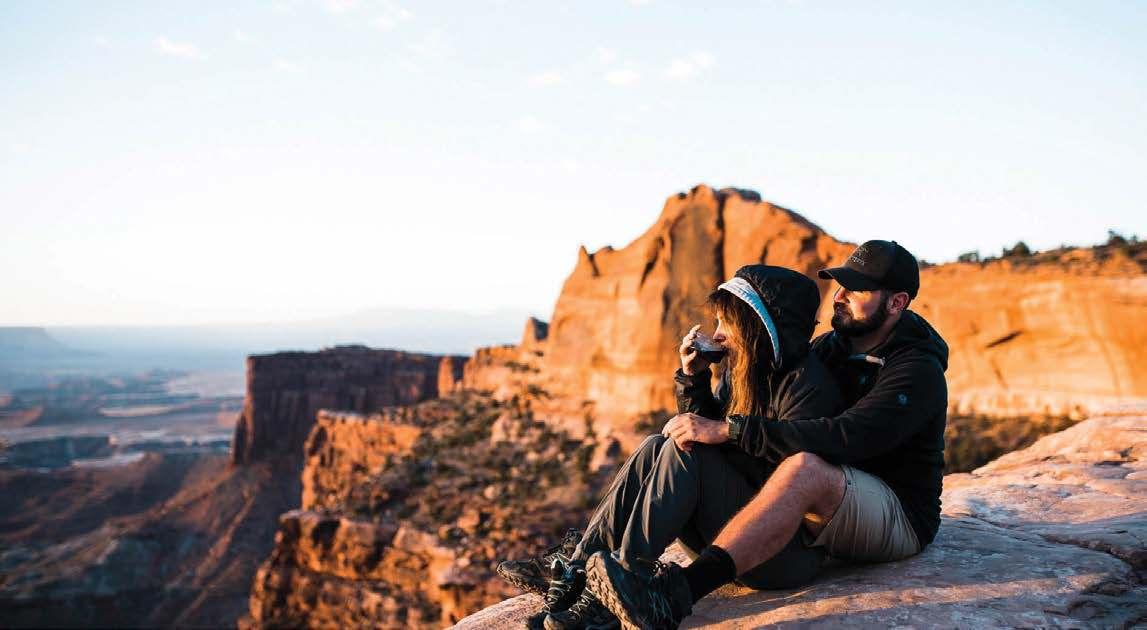


less on our monthly trailer payment than we used to on one weekend at an Airbnb or hotel. Our most recent elopement took us down to Redwoods National Park, and it was the perfect homebase.
One of our favorite quotes is “The trouble is, you think you have time.” We’ve never really understood waiting until retirement to do the things you want to do! What if you don’t make it to retirement? As morbid as that sounds, 2020 has reinforced that we only have the present.

It seems like Covid has forced us all to slow down and think about what really matters, what we’re passionate about, how to be intentional, and that plans are great, but being able to pivot and remain flexible is even better. It’s an important lesson for wedding planning during a pandemic and life on the road too.
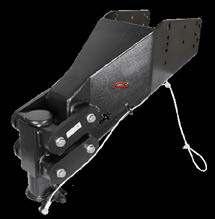
It has been a tough year, but we’ve been looking for all the silver linings we can find. Getting to work and travel together is definitely one of them. We’re trying to stay relatively local this year because of COVID-19, but our 2021 travel schedule is taking us to Yosemite National Park and all over the PNW, including Olympic, Mount Rainier, and North Cascades — we can’t wait!!

Find out more about Erika, Ryan and The Greatest Adventure Weddings at thegreatestadventureweddings.com and follow their travel adventures on Instagram at @thegreatestadventureonwheels

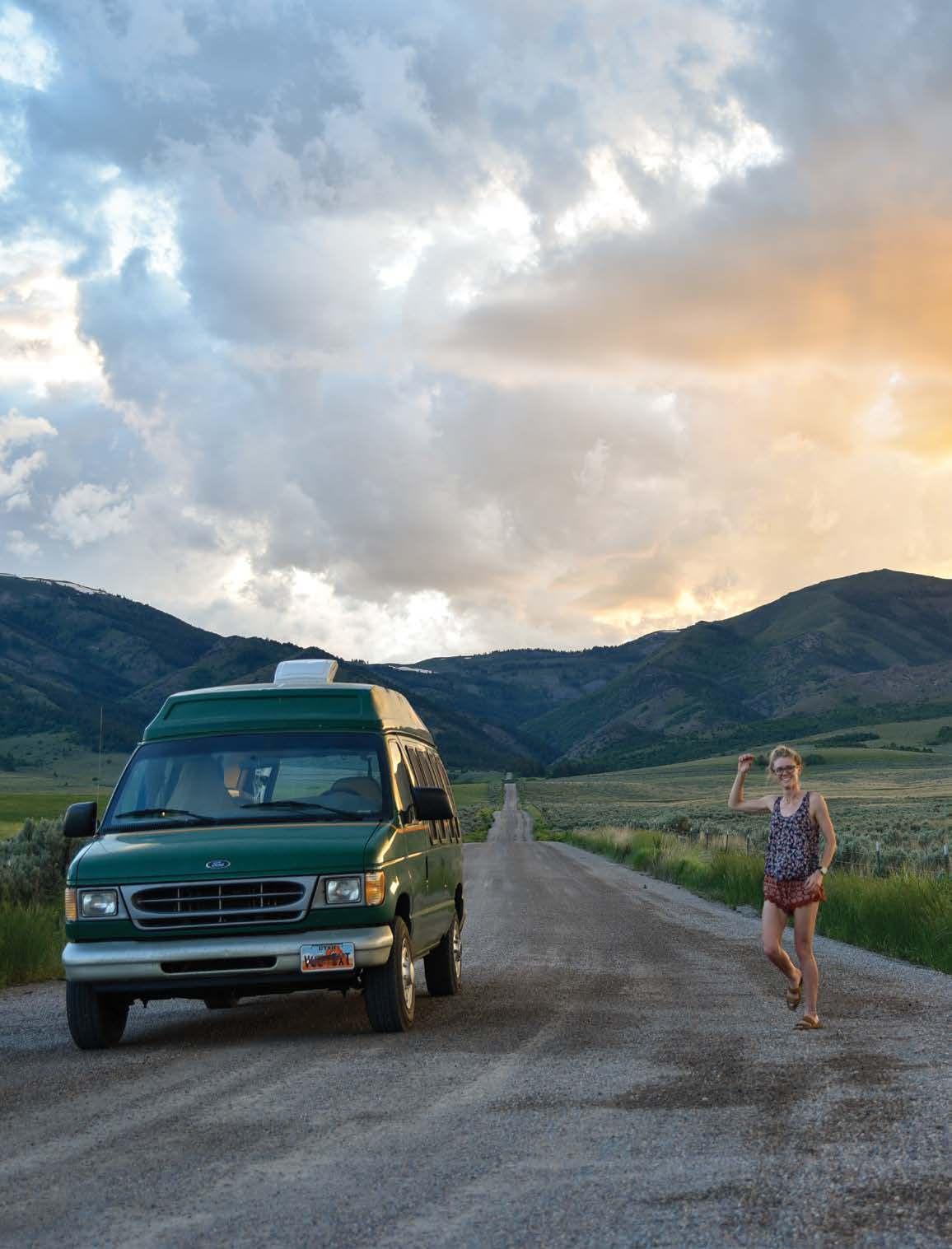
The day my life changed started out as ordinary as any other. Just over a year ago, I went into work and made my yogurt parfait like I did every morning. I sat down at my desk, took a bite, and boom! My heart started racing, my vision went white, my palms started sweating, and all I felt was impending doom.
I was having a mild panic attack. And while today I think it’s hilarious that a yogurt parfait triggered it, I know the trigger wasn’t really the parfait — it was my hollow routine that the parfait represented.
I was over six years into a corporate marketing career and hadn’t felt excitement for it in a long time. Like many people in their late 20s, I started asking myself, “is this … it?” The thought of working on projects that didn’t excite me to fulfill someone else’s dream, of only having 2-3 weeks of annual vacation until retirement, it started to terrify me.
I knew my yogurt parfait attack was my body’s way of kicking me into gear. It was time to shine a spotlight on my life goals. After a lot of consideration, I came up with a short list of changes to make. My goals were to work remotely, be my own boss, and have the freedom to be where I want, when I want.
I soon realized that vanlife fit the bill in every way. I could explore at my own pace, save money while building out a business (and figure out what I wanted to focus on), and escape the noise of societal pressure. But new questions and fears came knocking.
Could I handle living alone in a van? How would I stay safe?
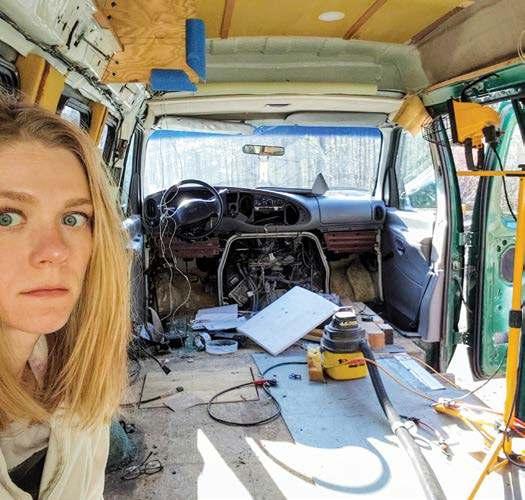
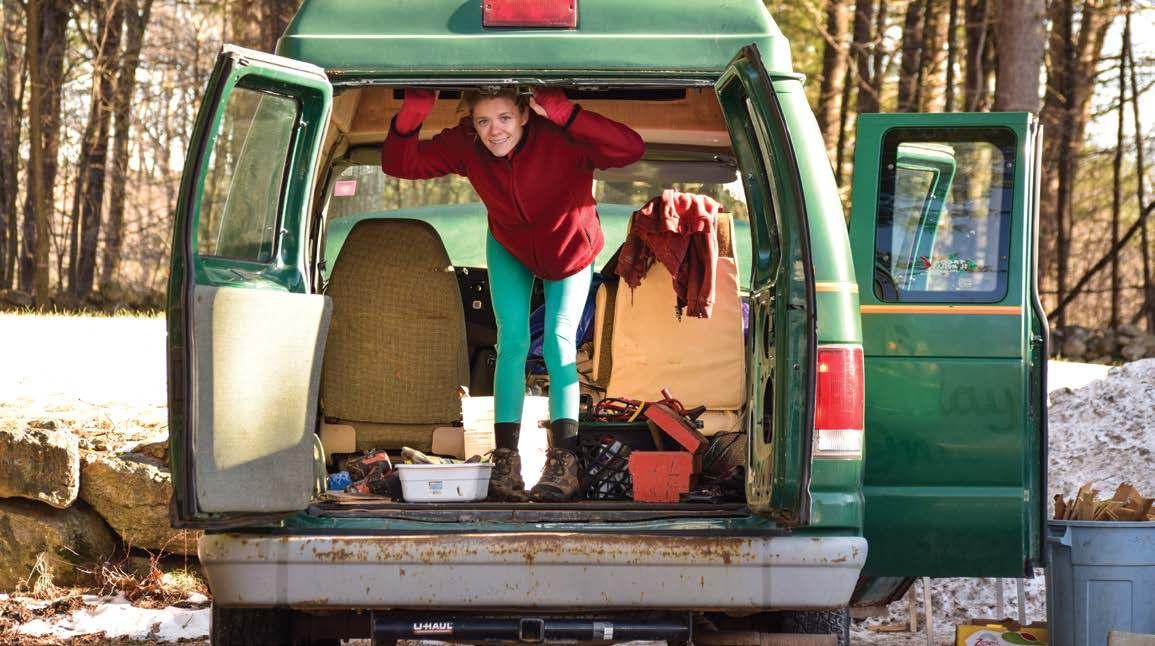
How would I financially support myself? As I wrestled with these questions, I realized some just couldn’t be answered until I was on the road. So I decided to dive in and not overthink it.
Within a couple weeks of my yogurt attack, I’d found my ideal van and was prepared to purchase it and quit my job. The van was located in Toronto, so I booked a one-way flight from Utah, sent my two weeks’ notice to my boss, and called my parents to tell them the exciting news.
“Why … would you quit your job … without another lined up?”
My mom’s voice on the receiving end was in scary mode. The kind where you talk quiet and slowly because you’re trying to hold back from yelling. Somehow it hadn’t occurred to me that my parents might not be as excited as me about
“Why wouldn’t you have me look over the van before deciding to fly out to Canada to buy it?” my dad asked. I responded, “because you just would’ve talked me out of it.”
I’ve done my fair share of travel over the years — lived in Beijing, explored Spain and Thailand, and moved across the country after college. My parents were always supportive. But these were planned trips with clear end dates or goals. Things that helped ensure my safety and overall future.
Quitting my job without another lined up and buying a twenty-year-old van without seeing it in person was concerning to them. And it SHOULD be. But I think my travel experience helped instill confidence in them and assure them that I’d figure it out.
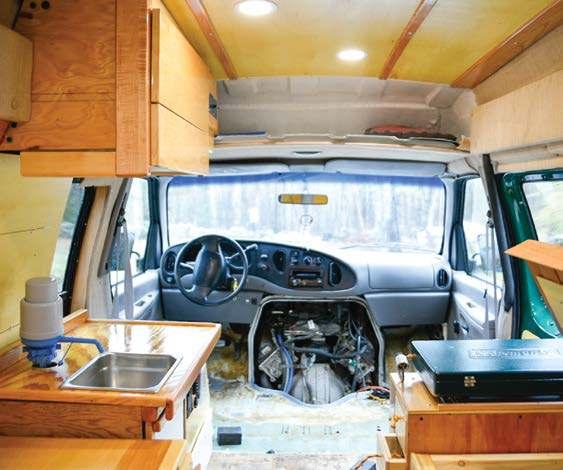


The van I selected for my new life on the road was a 1999 Ford E250 that used to be a Holiday Inn shuttle bus. It still has the retro green color with a yellow stripe and an odometer reading north of 180,000 miles. You could say it has a lot of character.
This van spoke to me because it was the first one that was already built out and within my $8,000 price range with an asking price of $6,000. A friend of a friend was selling it, so that reassured me I was getting an honest review of its condition. And quick note: When I say it was “built out,” it was a very bare-bones build with a fixed bed frame and loosely-secured table as a kitchenette.
I expected the van to need some mechanical work, but I was prepared to pay for that. I ended up meeting my dad in Toronto to pick up the van. I had no shred of doubt that every fiber of his being wanted to stop me from signing those papers over from the previous owner. But as the supportive dad he was, he refrained — already knowing the level of mechanical work that would be needed before I started traveling. Ha! We exchanged the papers for the keys and pulled an all-nighter to outrun a snowstorm to get back to my parents’ house in New Hampshire.
Over the next five months, I put $3,500 into brand new brake lines, replaced exhaust manifolds and the windshield, and improved other tidbits. I spent two weeks going back and forth on if I should sell the van after our mechanic came back with the $3,500 quote and a recommendation to “find a new van.” This was not how I’d envisioned the start of magical vanlife.
Ultimately, we ended up gutting the van and building it back out. While my head was spinning from the amount of mechanical, electrical, and automotive information being thrown at me, I also recognized that I was getting some serious quality time with my parents. This was a nice realization, because I don’t typically see them for longer than the holidays. But as we made improvements to the van, we also had enough time to break through the pleasantries
and fall back into our family roles.
The build-out phase only cost us about $1,500 thanks to re-using supplies in the garage and using some creativity. We continued the hotel theme of the van build by finding hotel-grade blackout curtains that only cost $5 from a hotel surplus store.
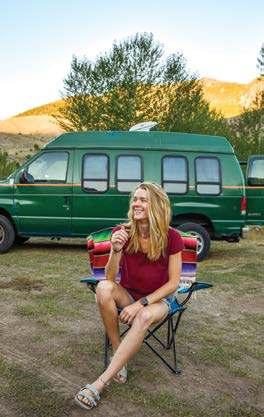
Funnily enough, the buildout helped show me what I care about: a good bargain. That’s why I’ve focused my website, greenvango.com, on helping frugal van enthusiasts on a budget get into the lifestyle. You don’t need a Mercedes Sprinter or a fat wallet to start this life, just a willingness to make a change and follow your gut.
Today, my tiny home on wheels is safe and fits my needs. I’ve got a ceiling fan, kitchen cabinets, and a double-burner stove. I also built a bench-to-bed setup that is convenient for having a work space, since I’ve picked up a couple parttime marketing jobs from previous employers. These jobs have helped me stay financially afloat and allow me to not have an end date on my vanlife adventure.
I’ve been on the road full-time for about six months and have started meeting new van friends. I spent the summer soaking up the rainforests and beaches along the Oregon and Washington coasts. I also spent a lot of time in northern Idaho, which is stunning — crystal clear and bright blue lakes, colorful mountain ranges and thick green forests.
When I reflect on building out the van and hitting the road, I realize those months were some of the most anxietyinducing months of my life. Every step of the way I worried I was on the wrong track.
But now I also see how things fell into place once I committed to the lifestyle. My dad ended up retiring a month into my van purchase, so I had his undivided help in building the van. Two previous employers happened to need some marketing help, so I’ve been able to work with great coworkers again and make ends meet. Things came together.
They say nothing great comes easy, and there is no greater feeling than throwing yourself deep into a project and actually coming out on top. I’m a big believer that the universe is in your favor so long as you’re in your own favor.
Sometimes it just takes a yogurt parfait panic attack to get clear on your life goals and make them your new reality.
About the Author Hilary Bird lives full-time in her self-converted ‘99 Holiday Inn shuttle bus. She does freelance marketing while traveling around the country and practices her saxophone to get back to her glory days. Inspired by her own budget build, she’s now dedicated greenvango. com to budget-friendly vanlife resources for other enthusiasts on a budget! Follow her on Instagram at @green.van.go

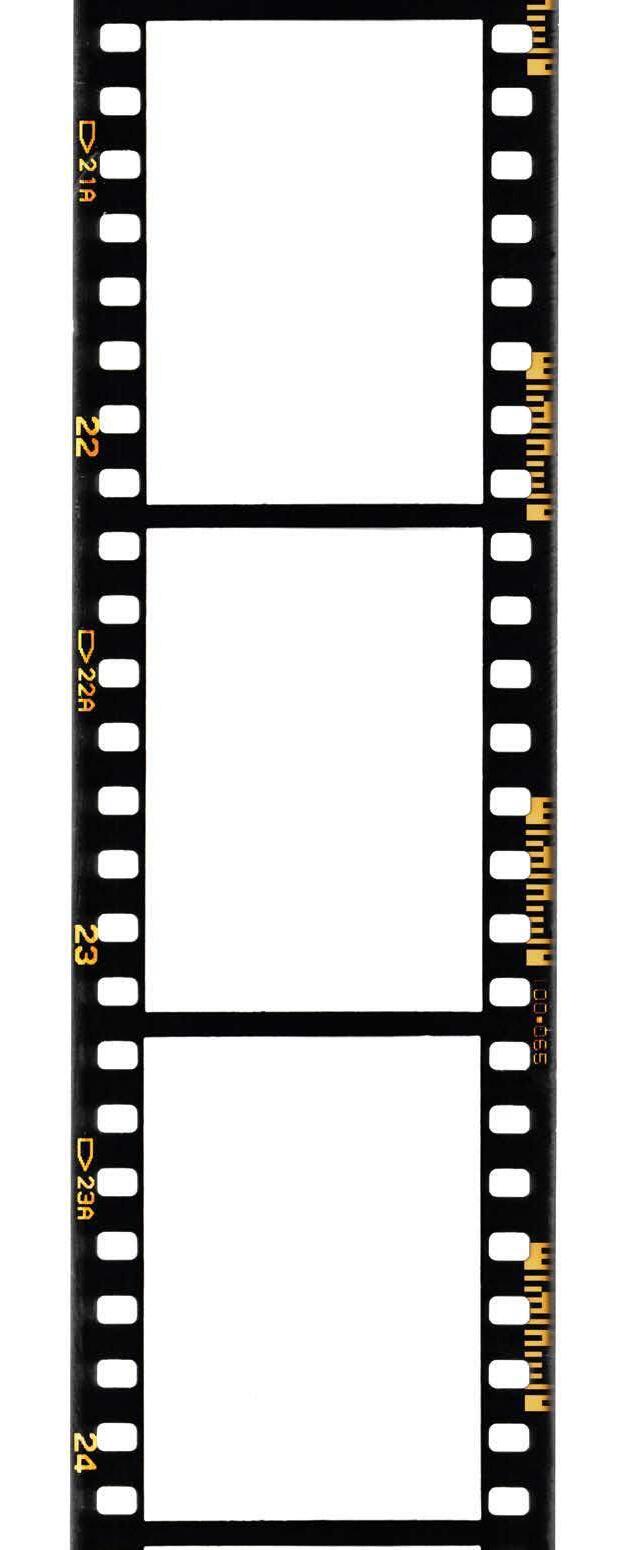

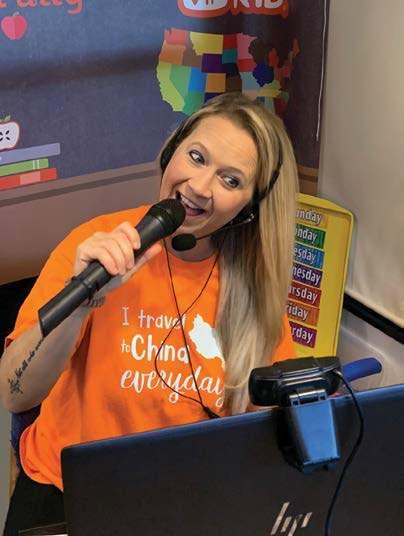
As a military family, we moved a lot—at least every three years. We loved moving, and every two years or so we would start to get the itch to pack up and move again. When my husband Shane retired after 24 years in the Air Force, we were finally ready to settle down. Or so we thought. After being in one spot for three years, we were ready for another change.
By Patty GillIn the last few years, we became empty nesters and have always talked about traveling full-time in the far-off future. I started watching YouTube videos of much younger couples hitting the road in their RVs full-time. Shane and I were sitting in a hot tub one night at a campground and decided, let's do it now! The only real question: How would we fund our adventure?
Shane receives a retirement check from the military, but it is not enough to fund our full-time adventure. I had been looking around on websites, blogs, and YouTube for different ways of making money online. A few years ago, a friend of mine suggested something that might be a good fit for me: Teaching ESL (English as a Second Language) online through VIPKID, an platform that connects North American English speakers with young Chinese students.
At the time I had a full-time job working for the government and didn't need a part-time job. Then I stumbled upon the Facebook group “VIPKID Teachers and the RV Life,” and I was blown away at the amount of people who teach full-time from their RV. I knew this could be exactly what I was looking for, and I immediately contacted my friend and asked how to get started.
I’ve had a great experience working with VIPKID. You can earn between $14 and $22 an hour depending on your experience, and you can also receive bonuses and incentives for each class. As a part-time teacher, I make between $400 and $1,000 a month. I teach students between the ages of 4–11, and the classes are one-on-one and only 25 minutes long. Fortunately, you do not need to know how to write a lesson plan—this is all done for you. The question I get asked most when I tell someone I teach English to kids in China is if I speak Chinese. The answer is no, you do not need to know how to speak Chinese or Mandarin, and most of the kids I teach can already speak some English.
The best part of teaching for VIPKID is that you get to set your own
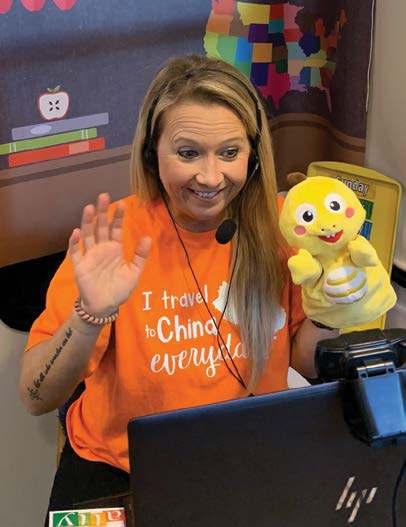
schedule. They are very flexible and do not require you to work a certain number of hours a week. You can work mornings or nights, weekdays or weekends. I teach every Tuesday, Thursday, and Friday morning, and I am slowly adding more students, hours, and days so that I will be full-time once we hit the road. I recently took off two weeks of work for the holidays, and all my students booked classes with me as soon as I started back up. Another great part is you can teach from anywhere— your home, hotel room, car, or RV.
To teach for VIPKID you need to be from the USA or Canada, have a bachelor's degree, and have experience working with kids. You will also need a reliable computer, laptop, or tablet with high speed internet. They prefer you are hardwired into the internet, but I have always used Wi-Fi and have had no issues. I would suggest if you are full-time in your RV to get your own high speed internet and not to rely on the campground internet. Some recommendations to make your classroom better include using a webcam, a headset with a microphone, and having good lighting. All of these can be found easily, and you don’t need to spend a lot of money to get started. I bought all my accessories for less than $50.
To start working with VIPKID, make an account, apply on their website vipkid.com and use a current teacher’s referral code. All teachers receive a small, one-time incentive for referrals once the person who used their referral code teaches their first class. Your referral teacher will become your mentor and help you through theapplicationprocess.Ifyoumakeitpasttheapplication process, you will then need to record a teaching demo video. It is very easy, and you will do it right on their website.
Next, you must teach and pass a mock class. This was the hardest part for me—it took me three times to pass it. There are current teachers watching you teach a class, and it takes a few times to get it just right. Once you pass these three stages, you will be sent your contract to sign with your terms and pay. I was so afraid for my first class, but after I taught a few lessons it became easy and fun. VIPKID even offers free courses and certifications for their teachers.
A normal teaching day for me starts very early in the morning. Depending on the time of year, I sometimes start teaching at 3 a.m. I usually wake up around 2:30 a.m., which may not be for everyone, but you can teach in the evenings if you prefer. Getting dressed for the job includes keeping on my pajamas and putting on a solid color t-shirt or sweatshirt. I put on a tiny bit of make-up and brush my hair or put it in a bun. I usually teach 5-8
classes each morning with about 5 minutes between each class.
To set up for each class, I will look over the lessons the day before to see what I will need to teach. It usually takes me about 20–30 minutes to make sure I have all my props set up for the next morning’s class. Then I grab my coffee, sit in my chair, and wait for the class to start. I’ll teach for 25 minutes, making sure to complete all the teachingslides,andoncetheclassesarecomplete,Ihave 12 hours to provide feedback for the students. This is a short review to let the parents and VIPKID know how the student is doing in class. I am done around 7 a.m. and have the rest of the day to explore, hike, or go sightseeing.
As a military spouse I have worked a lot of jobs while moving every couple of years. This is one of the best workfrom-home/RV opportunities I have come across. It is by far one of the best jobs I have ever had. It is very rewarding, and it is a job where I feel I am making a difference. I’m not getting rich, but I will make enough money to help supplement our income so we can hit the road full-time. I have worked for VIPKID for 2 years and just love the kids I teach, the flexibility, and being able to work from anywhere. Teaching with VIPKID is a great job to have if you want to travel and have a steady income, all while loving what you do.
If you are interested in teaching with VIPKID you can use Patty’s Teacher Referral Code ‘PATRI0422’. Follow Patty and Shane on Instagram at @gills_on_wheels for more!

The best part of teaching for VIPKID is that you get to set your own schedule.
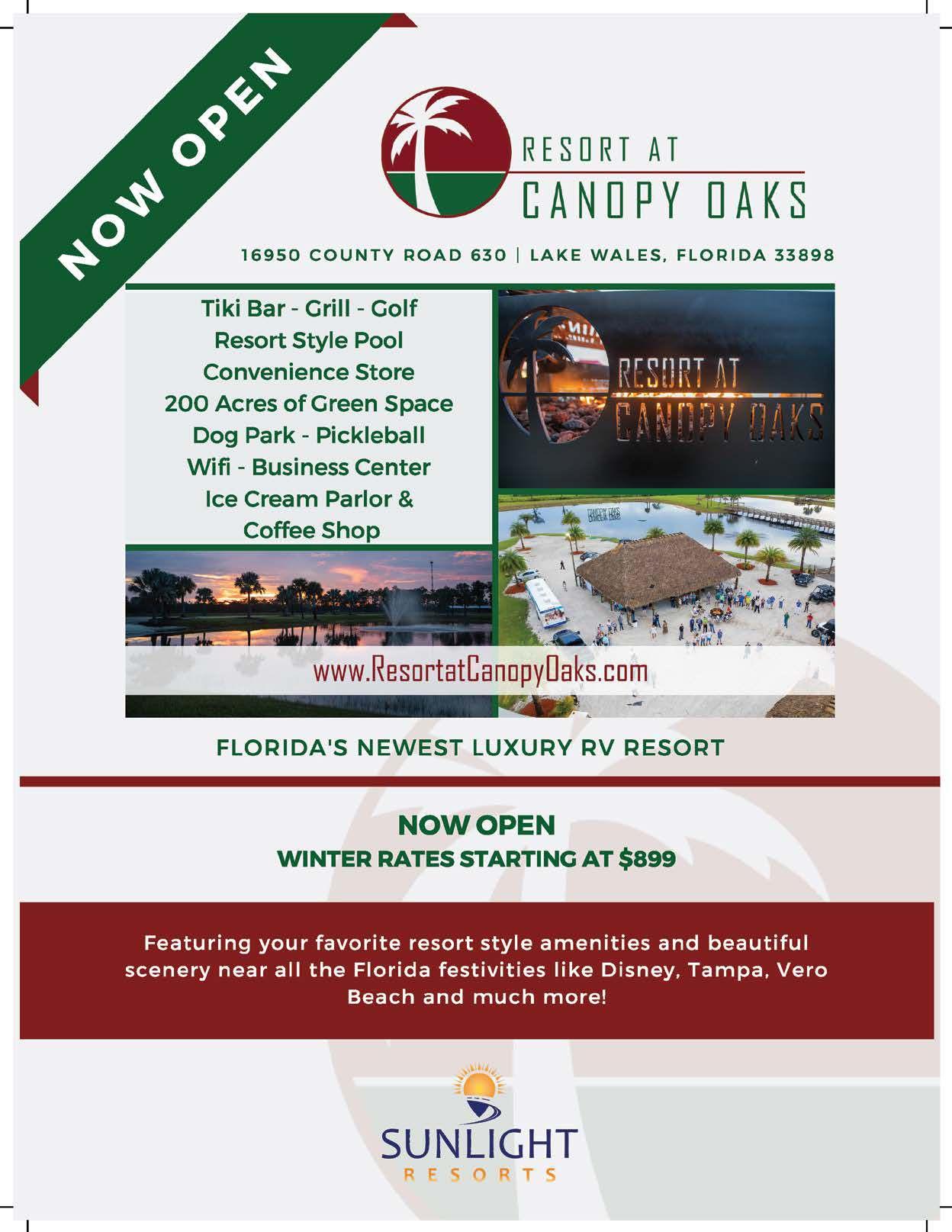
Just like every great road trip, sometimes life takes you in a new direction. At Heartland, we’ve launched a new journey to make our RVs better than ever. We’ve doubled down on seeking out the highest quality materials, creating fresh and inviting interiors and giving every unit the kinds of finishing touches you’d find in a new home.
Every unit goes through a top-to-tails inspection with a quality assurance expert—in fact, we have an 89,000-square-foot facility dedicated to walking each RV through a series of checklists to ensure it works exactly as it should. And with updated floor plans incorporating features our customers love best—spacious bathrooms, designer kitchens, furniture meant for cuddling up together—we’re confident every trip in a Heartland will be a happy one.
After all, that’s what RVing is all about: hitting the road with people you love, having adventures, making memories. So when you buy a Heartland, just focus on taking the journey of a lifetime. We’ll take care of the rest.
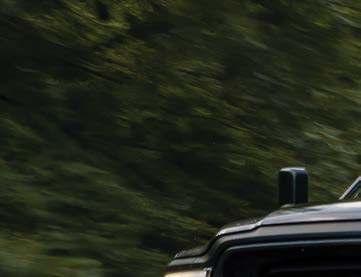
Experience the all-new Heartland online and check out 360-degree model tours, detailed floor plans, all-new features, galleries of updated decor and more.
Just visit HeartlandRVs.com.






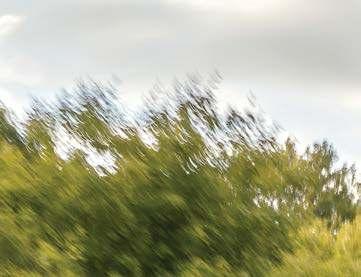
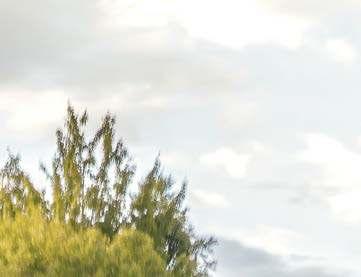




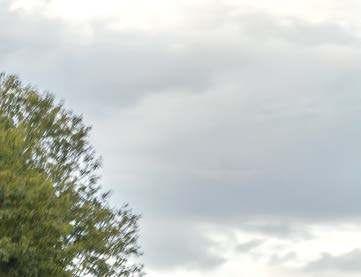


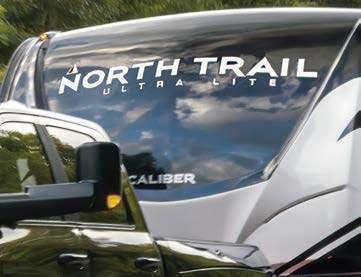
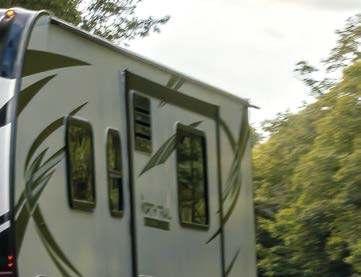

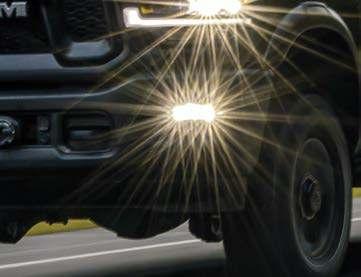
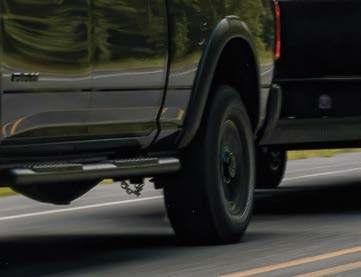



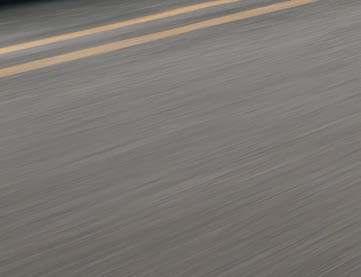





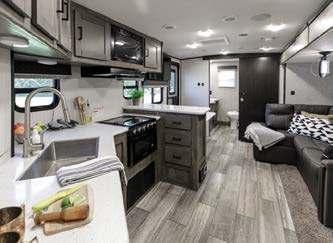

These are just a few of the statements we, Kelley and Renee Hayes, heard from family, friends and co-workers when we told them we were going to sell everything and live in our camper. We began tiny living two years ago when Kelley’s job with General Motors relocated us to the Atlanta, Georgia area. We had purchased our 2019 Keystone Raptor 421CK fifth wheel toy hauler a few months prior to use for weekend camping trips, but we had no idea it would soon be our home on wheels.
Full-time RV life was not our original plan. When we hauled the camper to Georgia during Christmas 2018, it was for Kelley to live in until we found a home. We were driving

around Georgia not having any luck finding a home when I said, “let’s just live in the camper.” From that point on our tiny living story began.
Some people assume that families who live in their camper or RV are on the road traveling full-time. That was not the case for us, at least initially. The first year, Kelley had a normal 8-5 office job. Our living arrangement was stationary, and we were weekend warriors, only able to travel on weekends, holidays and vacations.
Since making the switch to living tiny, we no longer spend our weekends doing yard work or cleaning the house. Instead, we began enjoying the great outdoors and hiking intheNorthGeorgiaMountains.Exchangingouroldlifestyle to live tiny has opened up more time for adventures — both in our backyard and across the country.
Once we adjusted to life in the camper, we began to seek out local adventures that were now easily available to us. Georgia is home to 700 waterfalls, and we have hiked to 20 of them so far. Our most strenuous hike was also
“You’re doing what?!”
“You’ll never make it.”
“I could never do that!”
Kelley’s favorite: Sliding Rock Trail in Tallulah Gorge State Park. They issue 100 free permits a day to the gorge floor. After a difficult hike in, we found several waterfalls and a deep swimming hole in the remote section of the gorge. It was an experience to remember!
Soon, we began traveling further to find new outdoor areas to explore. We drove to Asheville, North Carolina and Marietta, South Carolina to hike to additional waterfalls. We hiked several sections of the Appalachian Trail and look forward to hiking more sections of it. My favorite fall hike was to the Len Foote Hike Inn, which is a five-mile trek through the foothills of North Georgia. For the return trek, we hiked the Approach Trail. It was such a neat experience. The food was excellent, and we met great people along the way.
Believe it or not, we parked our camper for our entire first year of tiny living. We moved the camper to Georgia in December 2018 and didn’t haul it anywhere until October 2019 for a trip to Asheville. We had spent our entire first year taking day trips all over Georgia, so the morning we finally left for Asheville, we both turned into nervous wrecks.
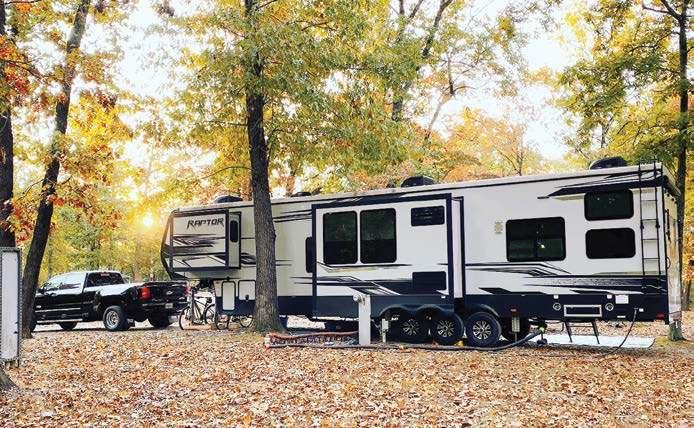

Now, the RV had an entirely new meaning. It was our house, and everything we owned was in it. When we finally started moving the camper, we nervously said “this is scary, everything we own is behind us.” Then a little further down the road, we realized “this is so cool, everything we own is behind us!” It’s a surreal, exciting feeling when you finally hit the road.
At long last, we were beginning to realize the freedom that comes with being a digital nomad. A favorite saying of Kelley’s now is “we may be living tiny, but we have the world’s largest suitcase!” It sure makes it easier not to have to make a packing list or forget something at home.
COVID-19 changed the lifestyle for us like it did for most digital nomads.
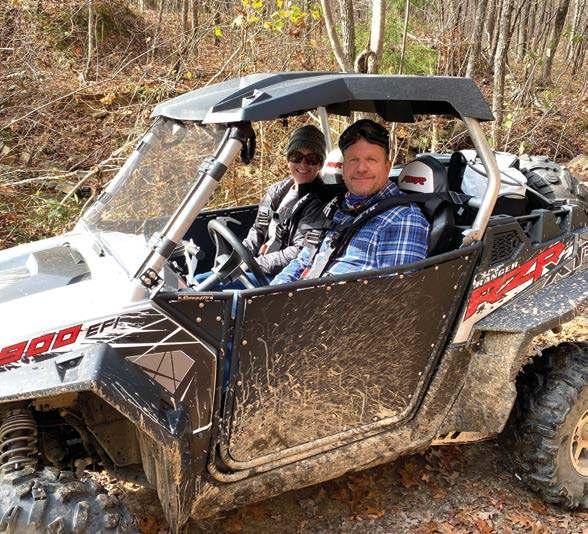
Kelley began working from home full-time in March 2020, which actually opened up the possibility for us to travel more than we previously had. Now, we travel to new locations on weekends and stay stationary during the week while Kelley works. This allows us to explore new places in the evenings and on the weekends.
So far, we’ve taken trips to Tennessee, Florida, and even a cross-country trip to visit friends and family. If it weren’t for the camper and the digital nomad lifestyle, we can’t imagine being able to take as many trips as we’ve been able to.
As we’ve worked and traveled in our camper over the last year, we’ve learned a thing or two about adjusting to the digital nomad lifestyle.
First, in order to work remotely on the road, it is very important to have a good internet connection. We use a Verizon Hotspot for service and utilize a Winegard ConnecT 2.0 4G2 booster to improve the internet connection when it is low. For TV entertainment, we use an Amazon Fire Stick to make our TV capable of accessing streaming services and other apps.
Second, make the time to choose the right camper or RV for you and your family. If you are not sure where to
start, rent a camper first. We started with a pop-up, then upgraded to a 28-foot Keystone Outback bumper pull trailer. We went to RV shows for two years to look at campers before we purchased our current fifth wheel, which has been perfect for us.

One thing in particular we love about our fifth wheel is its “garage” area, which serves us in many ways. It allows us to have plenty of sleeping room when our two grown kids, Amber & AJ, come to stay. We also use it every day as a mudroom, dining room and office. I can work out in one room while Kelley is working from home in his “office.” Recently, we used the garage area to haul a Polaris RZR to ride the trails at the Ouachita Mountains in Arkansas. The versatility of a garage area is very valuable.
Our final piece of advice if you are dreaming of making the move to tiny living on the road is to just do it! The lifestyle is extremely flexible — you can live in an RV or camper and be stationary or mobile. The advantages far outweigh the disadvantages. After all, tiny living has allowed us freedom from stuff, freedom from yard work and freedom to travel and seek adventure. If you don’t like your neighbors, that’s easy to change too!
Kelley plans to retire in a year, and we look forward
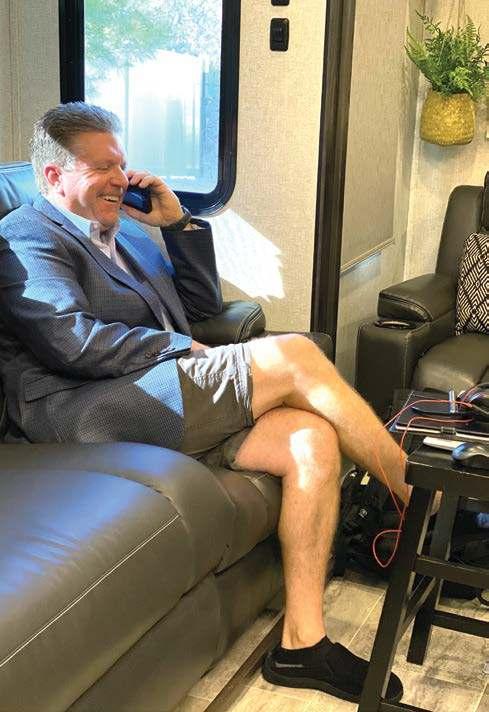
to traveling full-time. Being retired will allow us the freedom to camp anywhere and not have to worry about internet connections. Boondocking in Utah and visiting Yellowstone, the Grand Canyon, and the Redwoods are on our bucket list. We plan to live the snowbird lifestyle, spending our summers in Michigan and traveling through the southern states during the winter months.

We can’t believe two years have gone by since we first began living tiny. Making the move to become digital nomads was one of the best decisions we have made, and some of the people that originally thought we were crazy are now considering the lifestyle themselves. Now they say, “That is awesome!” “We want to do that,” and “We need to look into that.”
To follow along with Kelley, Renee, and their tiny living adventures, find them on Facebook, Instagram and YouTube with @fiftyandfifthwheeling.
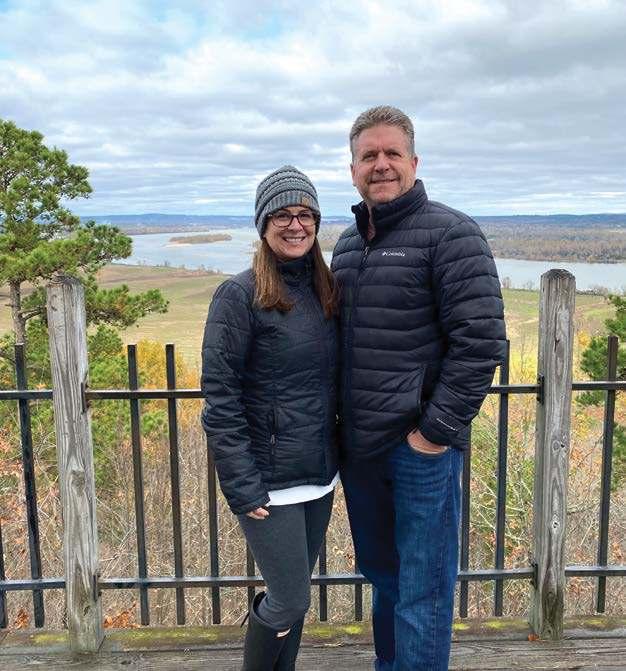
Multi-Use Portable Cellular Signal Booster
ï
Our most versatile cell booster yet - includes multiple antennas & mounts, a collapsible tripod, and carry bag.
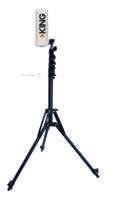
ï
ï
ï
ï
Use anywhere you go.
Includes 12V and 110V power supply.

Boosts voice & data range for multiple users and all U.S. cellular carriers.
Use while parked or in-motion.

Boosts and extends cell signal providing greater coverage and speeds for all cellular devices.


ï
ï Designed for RVs, trucks, travel trailers and more.
ï
5G Ready and 4G/3G LTE Voice and Data
ï
ï

Use while parked or in-motion.
Roof, pole, and ladder mounting brackets included.
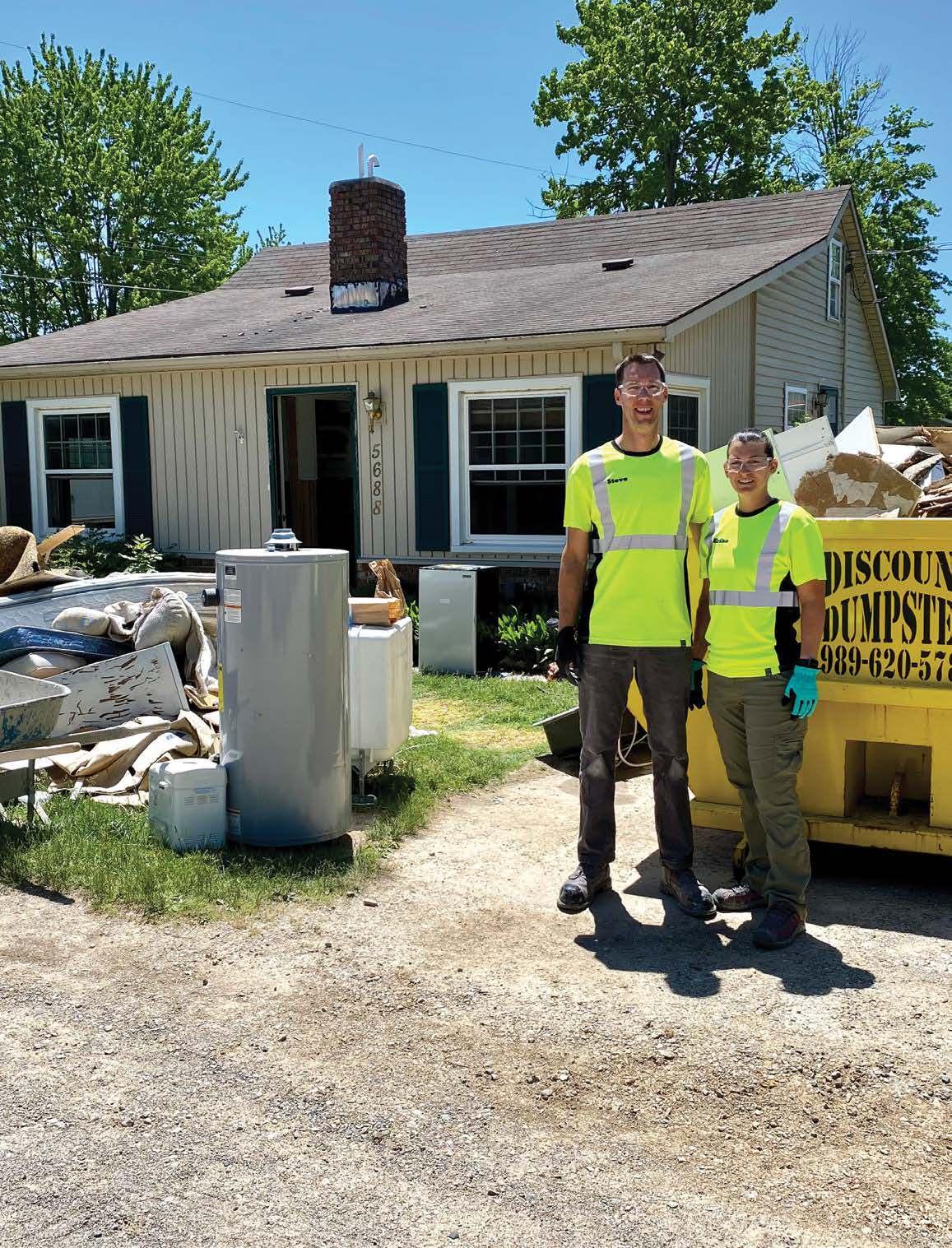
Many people become digital nomads for the freedom to pursue a different lifestyle, whether that means traveling to new places, living tiny on the road, or finding more fulfilling work and quality of life than could be found elsewhere. But even if you’ve been a part of the digital nomad community for years, there’s always surprising and unique ways to make a living on the road.
From 100-hour workweeks owning and operating a dirt car racetrack to the rewarding work of disaster relief efforts, Steve and I have turned our passions and work ethic into a life of travel, full-time RV living and affordable adventures.
Steve grew up in rural Michigan a bit of a mechanicallyinclined adrenaline junkie. Before he graduated high school, he was climbing his family’s 494’ communication tower to make repairs, racing cars at the local dirt racetrack and repossessing vehicles with his cousin in the middle of the night during his senior year. He had a passion for rebuilding engines, operating any piece of heavy equipment he could get his hands on and losing track of time doing the work he loved.
His true passions surfaced when he purchased an abandoned dirt race car track, spent 18 months renovating it and turned it into a thriving business at

the age of 25. He initially had a blast renovating the property and building the racetrack, but when it came to daily operations, his desire was to be out of the office chair. He would rather be in the road grader, backhoe or any other piece of heavy equipment that was around to tackle outdoor projects.
After the racing season ended in 2017, Steve was asked to take a temporary position working disaster relief. This position was to provide fuel to first responders after Hurricane Irma devastated the Florida Keys. When Steve first arrived, his tanker of fuel was assigned to support rescue workers in the Florida Keys to search every home looking for survivors who did not evacuate before the hurricane. Time was of the essence as they asked Steve how fast his truck could go, so he and the armed escorts, complete with flashing lights, led the convoy, cleared a path on the highway, and began rescue efforts.

How one couple started travelling full-time working construction jobs and providing hurricane relief
Driving through the Keys, Steve was stunned to find the piles of debris higher than the fuel tanker he was driving. The debris contained everything you could imagine from building materials to refrigerators and even campers and hot tubs. While this was a far cry from racing cars or climbing crazy-high towers, the immediacy of the need was enough to keep anyone’s adrenaline pumping for days. It only took this one opportunity before Steve knew he was hooked on storm work.
In 2018, I had my first experience boondocking in a borrowed travel trailer, and it was love at first boondock. Shortly after this experience, Steve and I were asked to assist on the recovery effort for Hurricane Florence in North Carolina. My first true boondocking experience was sleeping in my Army
truck while hauling supplies around Iraq in 2005. After my first experience working with Steve on emergency fueling, I was also hooked, and my ‘no, we’re not selling the business’ reply to Steve quickly became ‘let’s sell the business and start a new adventure.”
Our new adventure began in Spring 2020 when we made the jump to full-time RV living. Having sold the racetrack in the fall of 2019, the stars aligned for a new life on the road. We landed a contract position with a small construction company traveling to job sites around the United States. Steve operates heavy equipment, and I work as a laborer. Together, we work ten months out of the year, as needed, while taking September and October off from the construction company to work hurricane relief.

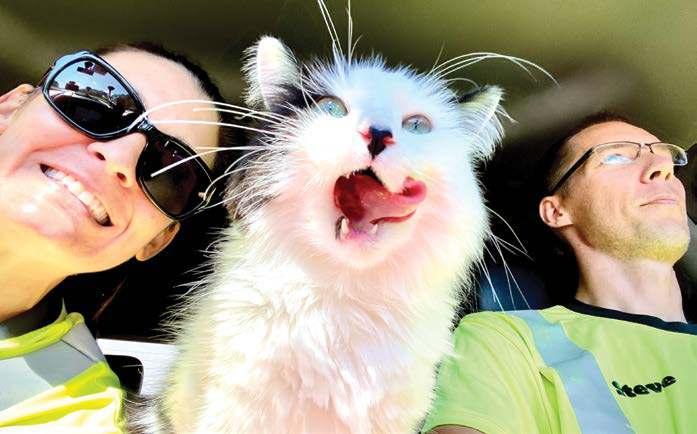
While working construction, the travel, food and lodging expenses to the jobsite are reimbursed, which helps them live fulltime in the RV. During our days off, Steve and I explore the area we are working in. When we have extra time traveling from one job site to the next, we turn it into a mini-vacation, exploring areas and stops along the way.
When COVID-19 shut down most of the construction job sites in 2020, it meant we had plenty of time to work during the hurricane season. It was a busy one, with several hurricanes coming one after another all aimed for Louisiana.
When it comes to storm work, it takes a mammoth effort to restore services after a
devastating storm. One key part of this work is ensuring that all first responders and emergency generators have fuel until power is restored. Emergency generators are set up at critical areas, which include fire and police stations, hospitals, evacuation shelters, communication towers, water treatment plants and lift stations, in order to keep these vital operations up and running.
There is usually a temporary shortage of fuel during emergencies. People stock up before a hurricane hits, and then gas stations oftentimes become damaged during the storm and cannot dispense fuel. The company Steve and I work for during hurricane relief sets up sporadic fuel depots exclusively for first responders like police, firefighters, Red Cross, Team Rubicon, church recovery groups, ambulances and other relief organizations. We also “wet hose” electrical lineman utility trucks, which means that once electricity is restored, the trucks are parked in long rows to be refueled quickly to be prepared for the next shift without delay. It’s not uncommon to refuel 100 to 500 trucks during the night shift.
Storm work sometimes takes long days and odd hours to get done what is needed, so having your RV home with you can make all the difference in getting prepared for another long shift.
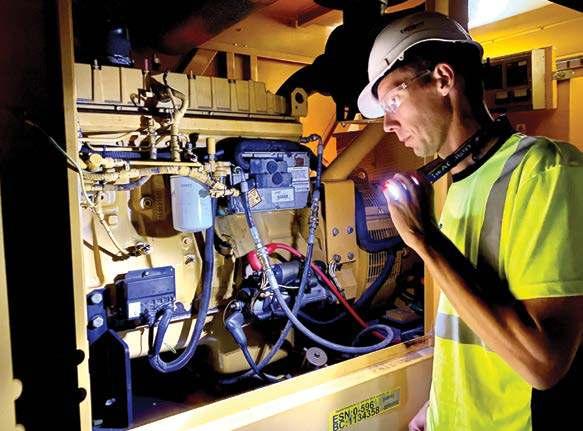
My original plan for our long-term RV life was to boondock at the hurricane sites we worked at. Unfortunately, this wasn’t the norm for relief company employees, so Steve and I weren’t sure it would work out when we first began. During storm times, hotels are difficult to find, and these areas also suffer from a lack of clean water, electricity, and sewer access. Luckily, at the end of August, Steve got the call: “Start heading down to Louisiana — you need to be here in three days to pick up a fuel truck and stage [prepare] for Hurricane Laura.”
It was go time! Steve and I loaded up our four cats and drove 12-hour days to make it on time. My military experience came in handy, so towing a 41-ft. RV was not as scary as it would be for most drivers. I received a few other driving lessons on the drive down from Steve, and then we joined the convoy of fuel trucks as they staged in the line of the oncoming hurricane.
Normally crews do not stage inside the path of the hurricane — they wait one state away and then drive into the affected areas after the storm passes. Steve and I planned to drive out of the path of the hurricane that night and drive back in for the 7:00 a.m. crew check-in time. Since we had a hotel room that accepted pets, we ended up staying with the rest of the fueling team at the hotel.
Needing to protect the RV, we discovered a closed mall and pulled the RV as close to the building as possible to protect it from the high winds. We left the truck hitched up, put the stabilizers down, grabbed everything we would be upset to lose if the RV was destroyed overnight, and slept in the
hotel. The storm hit at 1:00 a.m., and soon after, the power went out. On the top floor of the hotel with four terrified cats and the roof rattling, we attempted to get a few hours of sleep.
When the morning came and it was safe to go outside, Steve and I headed over to the mall parking lot. Thankfully, the RV was untouched. Going forward, we decided it would be better to just stay up all night and drive out of the storm path during future storms. The opportunity presented itself only 43 days later, when Hurricane Delta was predicted to hit Louisiana again. This time, we joined the local residents and evacuated Lake Charles to head inland. While this was the less-eventful option, keeping everyone and the RV safe was well worth the drive. After all, there will be more storms in the future — and we plan on being a part of the adventure!
About the Authors:
You can follow along with Steve and Erika’s adventures on Instagram at @RadarRoadWarriors. If you want to view the craziness of their recent hurricane adventure, the highlights are pinned to their profile under the “Laura” story. You can also find them on YouTube at Radar Road Warriors.

“I suppose you have one of those computer-type jobs.”
Our site escort looked at me out of one eye. “Don’t understand how you young people make money working on the computer all day.”
I smiled politely as I continued to wave my husband into our site overlooking the mountains of Glacier National Park. At that exact moment my phone buzzed. A new consulting call for someone struggling with their technology had just been added to my calendar.
… And that, I thought with a smile, is how I make money working on the computer “all day.”
If you’ve been traveling long, it’s likely come up.
A quick scan of any Facebook group of full-time travelers will show “How do you earn a living while traveling?” as one of the most popular newbie questions.
Even my own parents, who have always owned their own businesses, treat my husband and I as if we’re running a scam. Every time I see them, they ask me what I do as if they think I’ll trip up and give them a different answer.
Being able to check email in the morning, go out hiking during the day and return in the afternoon to respond to emails and work with clients is more than most non-travelers can understand. But it’s one of the many benefits of living the digital nomad lifestyle!

My personal journey in online business began back in 2012. I was a virtual assistant, and my husband had a six-week sabbatical from work. We did what any crazy parents of three middle schoolers would do in that situation and packed up our 19’ hybrid trailer and hit the road for six weeks. Each morning my husband took the kids to do something really fun, interesting, and just the right amount of dangerous while I worked for a few hours. In the afternoons, we’d adventure together or hang out and just be a family.
At the end of the six weeks, I had a crazy idea … What if we did this full-time? I was already working virtually, but it took a few years for my husband to work himself into a role that would allow him to do the same. Working virtually was definitely not the norm back then.
Today we’re empty nesters on our fourth year of full-time traveling. My husband is an actuarial consultant for a software company, and I help entrepreneurs set up and automate their online technology.
As we’ve traveled and embraced the lifestyle, we’ve run into more and more really cool things that other people are doing to make money while traveling fulltime. Here are a few examples:
Nomad Nation Gear produces products specifically designed for people who live on the road.
Alyssa Padgett of RV Entrepreneur turned her blog posts and travel questions people asked into a book: “A Beginner’s Guide to Living in an RV.” Whether you blog about specialized diets, online gaming or the best way to take a photo with your iPhone, you probably already have enough content (and followers) to put together a book you can sell online.
Ashley Logsdon of MamaSaysNamaste is an online coach and podcaster helping families, marriages and parents. You could take your knowledge and turn it into an online coaching business, course,or membership. Whether you teach knitting,
dog training or how to cook great Instapot meals, it is likely there are people out there who will pay for your expertise.
The reality is that you can have just about any type of business if you live in an RV full-time. An ideal business for the full-time traveler is one that allows you to work on your own schedule and isn’t location dependent.

As simple as it may sound, there are a few key steps in starting a business that will work for you as you travel:
Start with the right great idea. Ideally, this should be something you’re talented in and are passionate about. Think about the questions people come to you with all of the time. Are you the parenting ninja of your friends? Do you sew new things for your RV in your spare time? Are you an organizing superstar? What are you great at that makes you excited to work on each day?
Set up your business. Some of the things you’ll need to consider is whether you need a website to get started (hint: many new businesses do not), which email service provider to use, and whether you’ll need insurance.
Create and grow an email list. When creating an online business, the most important thing you can do is build a list of email addresses
of the people who love what you do. You may be surprised to know that when running a business, you cannot use a personal email account to send bulk emails. You must use an email service that specializes in sending automated sales and marketing emails. ActiveCampaign, Aweber and MailerLite are all good options.
Although social media will gain you popularity and traction, you’re at the mercy of the platform and its algorithms. It is no substitute for a list of engaged subscribers that will come to know, like and trust you and whatever it is that you have to offer.
Test your idea. There are many ways to do this without spending a lot of money. Create a free PDF or video as an introduction to the idea that you have and see if anyone is interested. Send it out to anyone who subscribes to your list.
Create the product. Once you have an offer that you know people are interested in buying, creating it becomes pretty easy. In fact, many people sell products before they are even created to ensure they have buyers for what it is they are trying to sell.
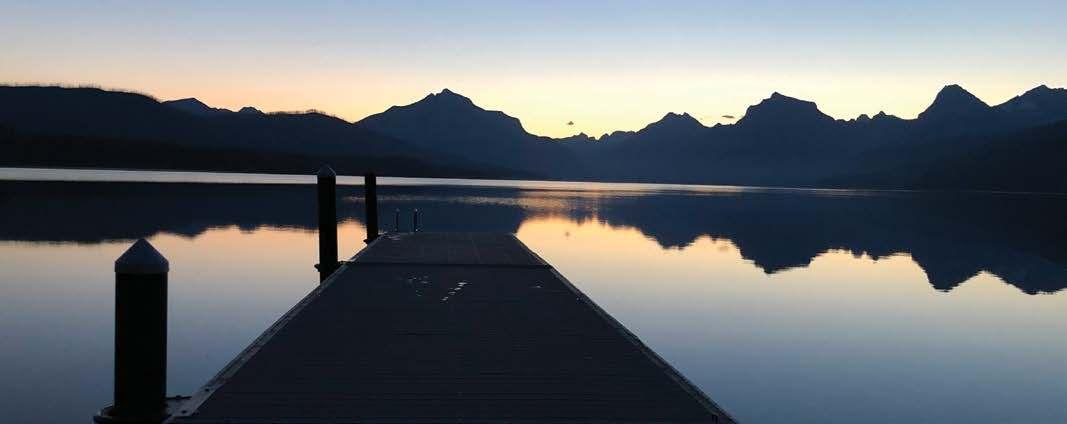
Great internet. When we first hit the road, we were warned that a strong internet connection would likely be our biggest obstacle. Turns out that’s been true. It’s also been one of our biggest expenses. Different parts of the country favor different internet carriers, requiring us to have hotspots for three major carriers in the U.S. Never plan on the campground Wi-Fi to be strong enough to run a business — no matter what the campground tells you.
For true flexibility, have a backup plan. Even though we do extensive research before we book a campground, we’ve often arrived somewhere

without a signal strong enough to work. When we’re booking a site we’re not sure about, we always have a backup plan (or location) in mind. When we know we’ll be off the grid for a few days, we make sure to have someone else checking our emails in case of an emergency.
Don’t fall in love with your idea too early. Be open to the idea that it may need tweaking or changing to become profitable. Discuss your idea around the campfire or with new people you meet and get their take. If they have questions or ideas, pay attention. Make sure you’re addressing those questions in your marketing and potentially changing your product to meet the ideas others might have.
Don’t let yourself get sidelined by the technology. Setting up an online business does require a bit of digital prowess. The good news is there’s nothing you’ll need to do online that you can’t learn. If you’re adventurous enough to take your life on the road, you can definitely find someone to help you with the technology.
Here’s to your online business success!


Taylor Cluster
One couple writes, designs, publishes, and launches their first fictional book — all from their RV
 By Taylor Cluster
By Taylor Cluster
We regularly get asked this question soon after our ultra-friendly golden retriever puppy, Finley, breaks the ice with strangers in a campground after the small talk moves on from “Where are you from?” and “How long have you been on the road?”
Although far from unusual these days, being millennials in an RV park and saying we’ve been on the road for over a year and a half, it’s hard not to wonder: How does a young couple afford RVing full-time?
Let’s jump back to early 2019 when we started brainstorming about how to scratch that travel itch. Scott
had been working seven days a week in real estate and was starting to feel burned out. Meanwhile, I wasn’t too crazy about my job at a non-profit preschool and the up-and-coming changes the organization was about to make for their employees. Scott tossed out the idea of buying an RV and moving into it to travel full-time across the country. To his surprise, I loved the idea and wanted to dive straight into figuring out what the next steps would be to make that happen.
In a matter of a couple of months, Scott put his house up for sale, bought a twelve-year-old RV, and we dove headfirst into renovating it and documenting the process to upload to YouTube. Like many others who travel on the road full-time, we put together a website, Instagram account, and YouTube channel to showcase our travels.
By the end of 2019, we could see that the only way to stand out from all the other travel bloggers, influencers, and YouTubers who had a huge head start on us was to do something totally different.

I’ve always had a love for creative writing, so Scott pitched me on the idea of writing a book. After doing some research, we discovered that plenty of people had written how-to books or memoirs of RV trips in years past, but no one had specifically written a fictional murder mystery novel that fell under the RV life or vanlife category.

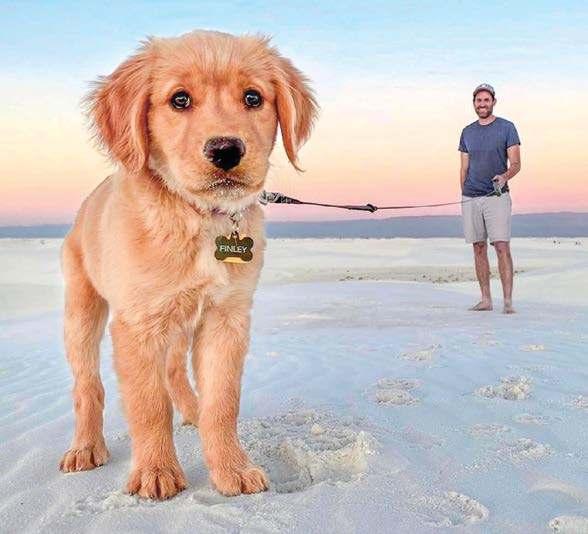
I began drafting a manuscript as Scott dove into the world of publishing, learning everything he could about the subject.
After hours of research, Scott concluded that self-publishing through Amazon’s Kindle Direct Publishing (KDP) platform would be the best route for us to take. Also, he determined that routing the business expenses through an LLC would make the best financial sense for tax purposes. We started Giant Saguaro Media LLC so that our book proceeds and expenses could be routed through the LLC, as well as our other revenue from our website and YouTube channel.
I hit the ground running and soon created enough of a storyline for the new company to begin looking for a design for the cover. Instead of designing the cover ourselves, we turned to 99designs.com, which runs a design competition. For $299, we had an overwhelming 101 designs submitted to us. We were able to narrow things down to a shortlist, ask the designers to make some minor changes to fit what we were looking for, and choose a design winner in just a couple of weeks.
Now that a product image was complete, we had something physical to launch our branding. Next, we turned to Upwork.com to find a web designer who would put a simple two-page website together for the book.
After creating the website, Mailchimp account, and Facebook page, we realized what we really needed was a mockup of the book, but a proof wouldn’t be ready for months and would also blatantly include the word “PROOF” on the cover. Thinking outside of the box, like many full-time travelers, we found a local printer in the tiny outfitter town of Ely, MN to print a color book jacket which they glued over a book we had picked up earlier at a secondhand bookstore. This way, I could pose in photos with my “book” that we could use when it came time for marketing.
After I completed the book's first manuscript, I let Scott dive into reading it and making the first developmental edits. When I initially started writing the novel, I told Scott he was allowed to read the first two dozen pages to proofread immediately. Then I realized that it would be better to have him wait until I built out the storyline and added suspenseful elements before handing it over. This way, he wouldn’t know where the story was going, and I could have the ability to go back and rewrite details and other clues into the earlier chapters of the book.
Once Scott and I did the initial edits and proofreads, we turned to Upwork again to find a couple of professional editors. The first editor we hired for $800 did three rounds of revisions: developmental, line edits, and a final proofread. All edits were tracked in Google Docs using the ‘track changes’ tool so we could see what changes had been made.
We then decided to hire two more editors to do final proofreadings, which cost about $200 each. Looking back, I wish we would have spent a little extra money here so that they would have more time editing the book. I also wish I vetted them better, because there were still a lot of errors found by our first few readers. Fortunately, Amazon KDP allows you to upload unlimited fresh files when you do find and correct a mistake.
Once the editing stage was complete, Scott used Adobe InDesign to lay out the final book to upload it to Amazon KDP in paperback ($14.99) and e-book ($4.99). We checked out what other books were going for before settling on prices. We ordered a paperback proof (at Amazon’s printing cost of $4.87, plus shipping) to the campground we were staying at and did some final tweaks to the book.
When everything was ready to launch, we did some final preparations and announced the product launch to the world by utilizing our Mailchimp newsletter and social media accounts. We ran ads before and after the book launch, targeting millennial readers with interests in outdoor activities.
Altogether, we spent about $2,500 to get the book published and launched.
If we could do it again, we would have spent more time building a launch team. It’s kind of a shame — with such an awesome RV/vanlife community out there, we really should have reached out and asked for beta readers. Not only can they catch some of the errors before it goes out to the general public, but they can also be your biggest advocates and provide extremely valuable reviews.
I am writing my next novel and plan to keep writing whether this becomes a full-time career or just a great way to add supplemental income. Scott plans to use Giant Saguaro Media LLC to launch a few of his own media projects and hopes to buy or develop a small RV park in the near future.

A self-described adventure enthusiast, in 2019 Taylor left her "anchored life" in Phoenix to hit the open road and live full-time in an RV to travel and explore North America. She can still be found rolling through the mountains, forests, beaches, and campgrounds hunting out experiences to serve as inspiration in her upcoming novels. You can grab a copy of Taylor’s book The #Vanlife Murders on Amazon and follow her adventures on Instragram @scottandtayy

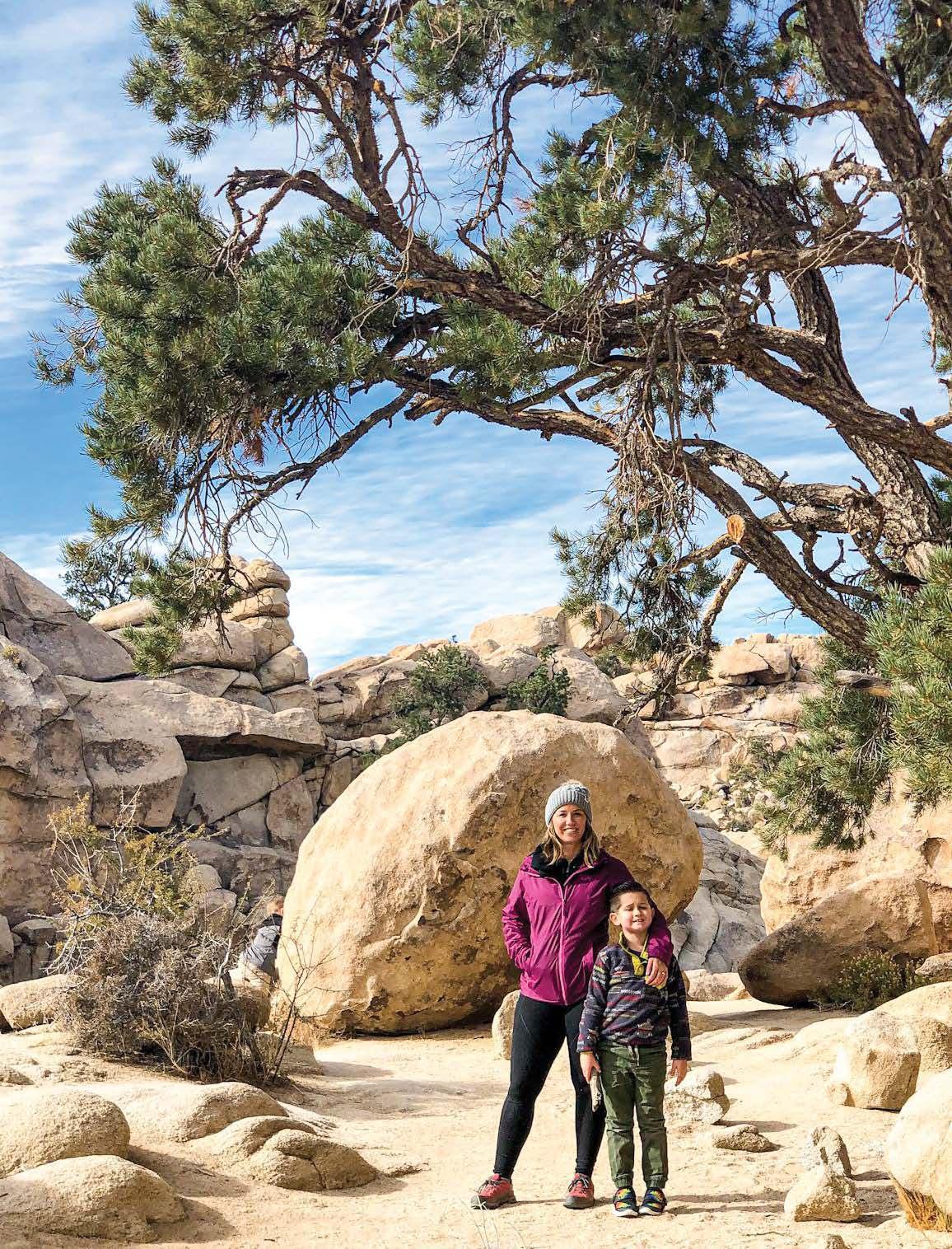 By Alexis Nascimento
By Alexis Nascimento
Amagical yet desolate national park, Joshua Tree is the ideal place to find solitude, hike to your heart’s content, and take in the most incredible desert vistas. Our family spent two months here in December 2019 and January 2020, and to this day it remains one of our most favorite destinations. Thanks to our extended time here, we've been able to put together a fairly comprehensive overview on Joshua Tree National Park. Grab a beer, throw on “Burning Man” by Dierks Bentley, and settle in for everything you need to know before visiting this vast protected land.
Best known for its iconic flora – most notably the everpresent, slow-growing Joshua tree – Joshua Tree National Park boasts 792,510 acres of stunning vistas and rewarding hikes. It’s a unique landscape as the park is made up of the Mojave and Colorado deserts.

The Colorado Desert, a western extension of the vast Sonoran Desert, inhabits the southern and eastern parts of the park. You’ll know you’re there when you see the tall, spike-like ocotillo plants and the “jumping” cholla cactus. Across the northern part of the park, you’ll find the southern boundary of the Mojave Desert. This is the home of the park’s namesake: the Joshua tree.
With the desert, you can expect a broad range of temperatures depending on the time of the year. One thing to note is that Joshua Tree National Park ranges in elevation from 536 feet in the park's extreme southeast corner to 5,814 feet atop Quail Mountain. This can lead to quite a variance in weather conditions depending on your exact location and altitude in the park.
If you’re looking for ideal weather conditions, the best timeoftheyeartovisitisMarchthroughMayandOctober through November. Though the park is open year-round, temperatures are most comfortable in the spring and fall
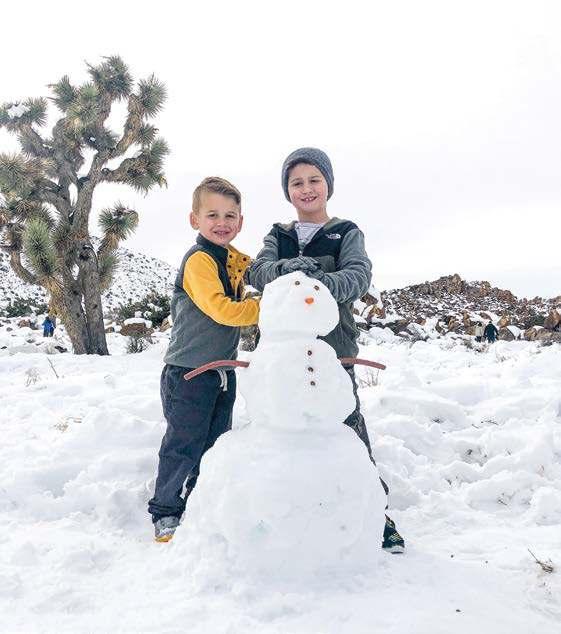
with an average high of about 85 degrees. We stayed here between mid-December and mid-January, when you should expect mostly crisp, sunny days. The highs were usually around 50-60 degrees (which is warmer than it sounds on a sunny desert afternoon), and 36-45 degrees at night. If you’re planning a visit during this time, be sure to pack plenty of layers!
Another perk of visiting Joshua Tree is that it offers an abundance of places to camp in and around the park boundaries. Within the national park, there are nine campgrounds with nearly 500 campsites! Most of these are first-come, first-served. Black Rock, Cottonwood, Indian Cove, Jumbo Rocks, and Ryan campgrounds

accept reservations from September through May, which is considered the high season for Joshua Tree. Reserved sites run $20-25/night, and first-come, first-served campsites are $15/night. There are also a handful of campgrounds outside the park, but the same rule of thumb applies here as far as seasonality and availability goes. Hipcamp.com is another great way to score a cool campsite if you’re not a fan of feeling like a sardine in an RV park.
If you’re looking to save some cash and are in a selfcontained RV, bus or van, you’ll definitely want to consider camping on Bureau of Land Management (BLM) land. It’s free to boondock, as long as you’re good to go without facilities like restrooms, hookups, water or trash. This also means you’re good with packing out whatever you pack in and following Leave No Trace guidelines. There are two easy-tofind locations on the north and south outskirts beyond the park.

Once you get settled into a campsite, there’s so much to do and see within the park. Here are a few of our favorites:
HIKING – There are so many incredible (and familyfriendly) trails in Joshua Tree National Park! During our month-long stay, I hiked nearly 35 miles altogether, with at least 20 of those miles logged with our boys. We absolutely loved Arch Rock (1.3-mile loop), Barker Dam (1.1-mile loop) and Mastodon Peak (3-mile loop).

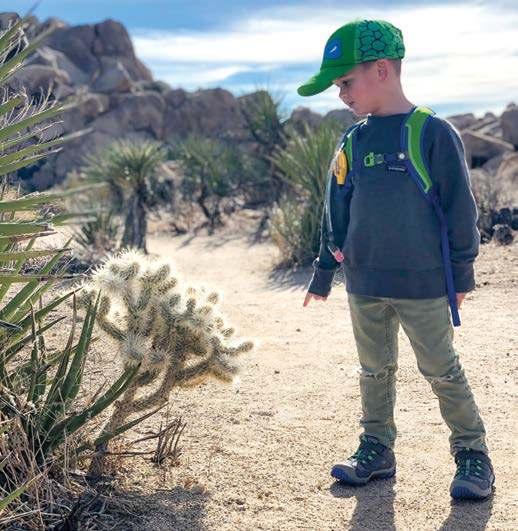
SCRAMBLING – Somewhere between hiking and rock climbing is our new favorite activity: scrambling boulders. It’s pretty simple. You use your hands and feet to walk up steep terrain, and Joshua Tree offers some of the best given the massive rock formations. Some of our favorite spots to scramble (and hike) were Hidden Valley Nature Trail, Split Rock Loop and Hall of Horrors.
CLIMBING – You can’t go far in Joshua Tree National Park without spotting ropes and climbers. While we’re not climbers (yet?), this is THE spot to climb. If you want to learn while here, there are plenty of outfitters who can teach you the ropes.
CATCH THE SUNSET – I’m not sure I’ve ever seen more beautiful sunsets than I have in Joshua Tree. The kids named these “cotton candy skies,” and they did not disappoint. As the sun descends, the sky changes color from orange to pink and finally to a deep purple before darkness sets in. While I’m not sure there’s a bad view in the park, our all-time favorite was hiking the High View Nature Trail as the sun set. Epic!
STARGAZING – Joshua Tree is THE place to take in the night skies. With minimal light pollution, you can literally stare up the stars for hours. I highly recommend downloading the Sky Guide app. We pull it out almost every time we’re outside after dark. It will tell you all about the constellations, stars, planets and moon activity. We’ve spotted many planets this way!
What we discovered during our extended stay is that Joshua Tree is absolutely incredible, and beyond what I could have ever imagined. As you drive through the park, there are thousands of Joshua trees as far as the eye can see, and majestic, rocky mountains peppering the skyline. Little did I know that this desert wilderness would nourish my soul more than any other destination we’ve been to on Our Great Big Adventure. It’s safe to say we’ll be back!
Alexis Nascimento is a wife and mom of two boys and has been traveling full-time with her family in a converted Sprinter van since June 2019. She enjoys hiking, reading and everything about living tiny. You can find her family’s adventures on Instagram at @NeverSaySomeday as well as her travel guides at NeverSaySomedayFamily.com.

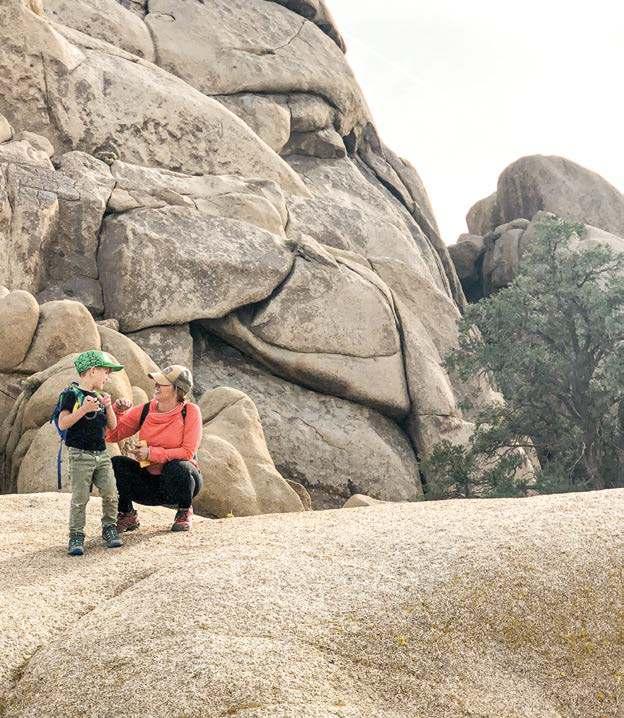

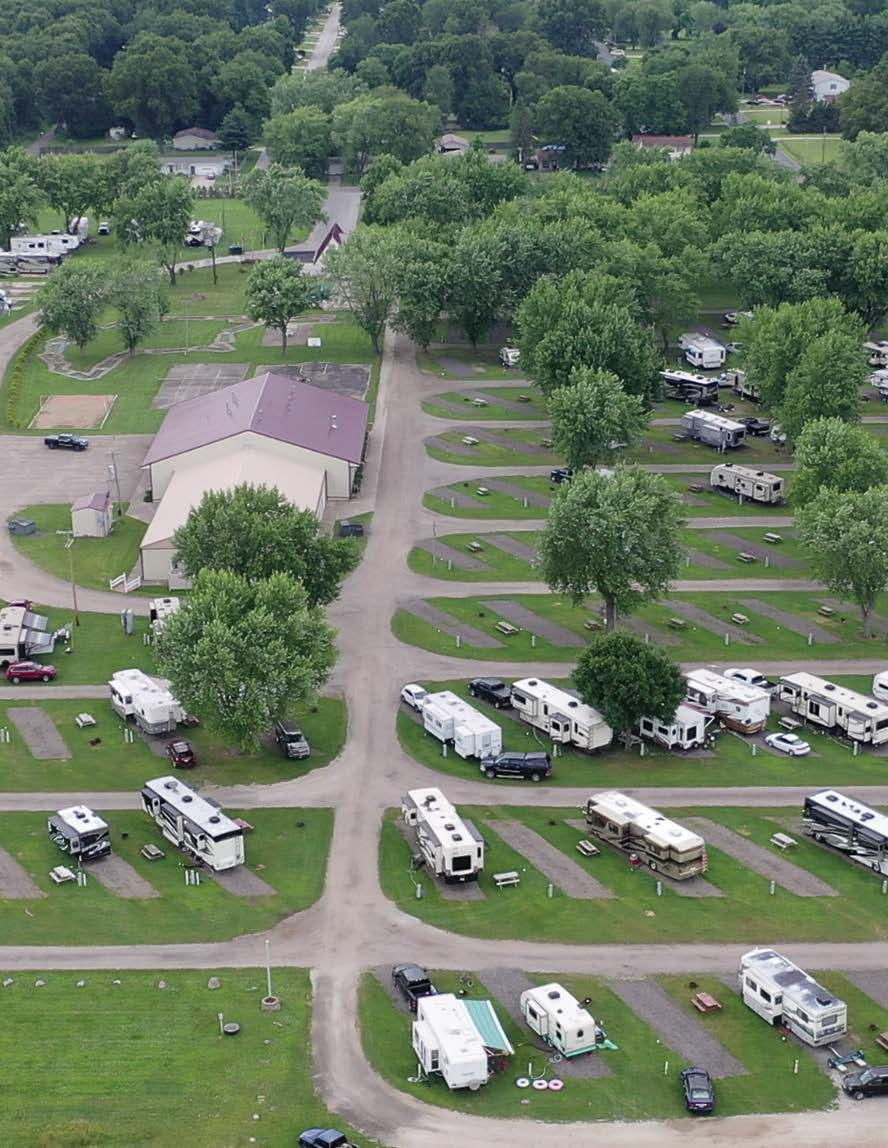

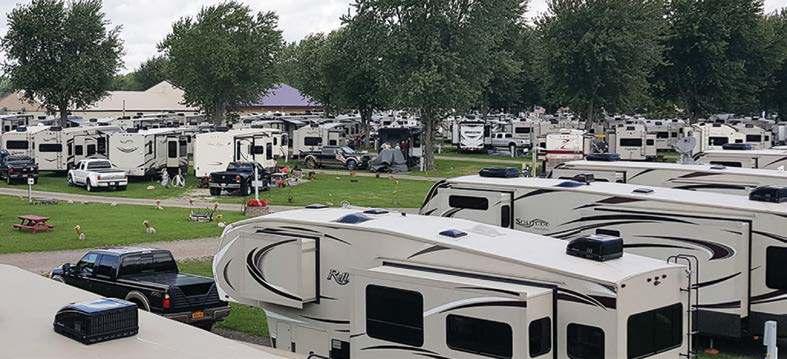
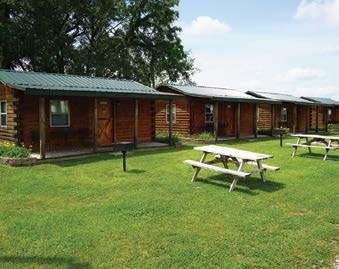

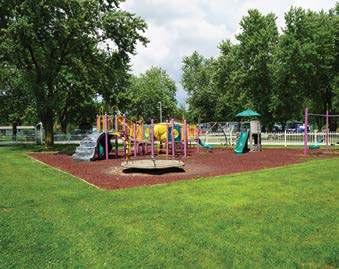
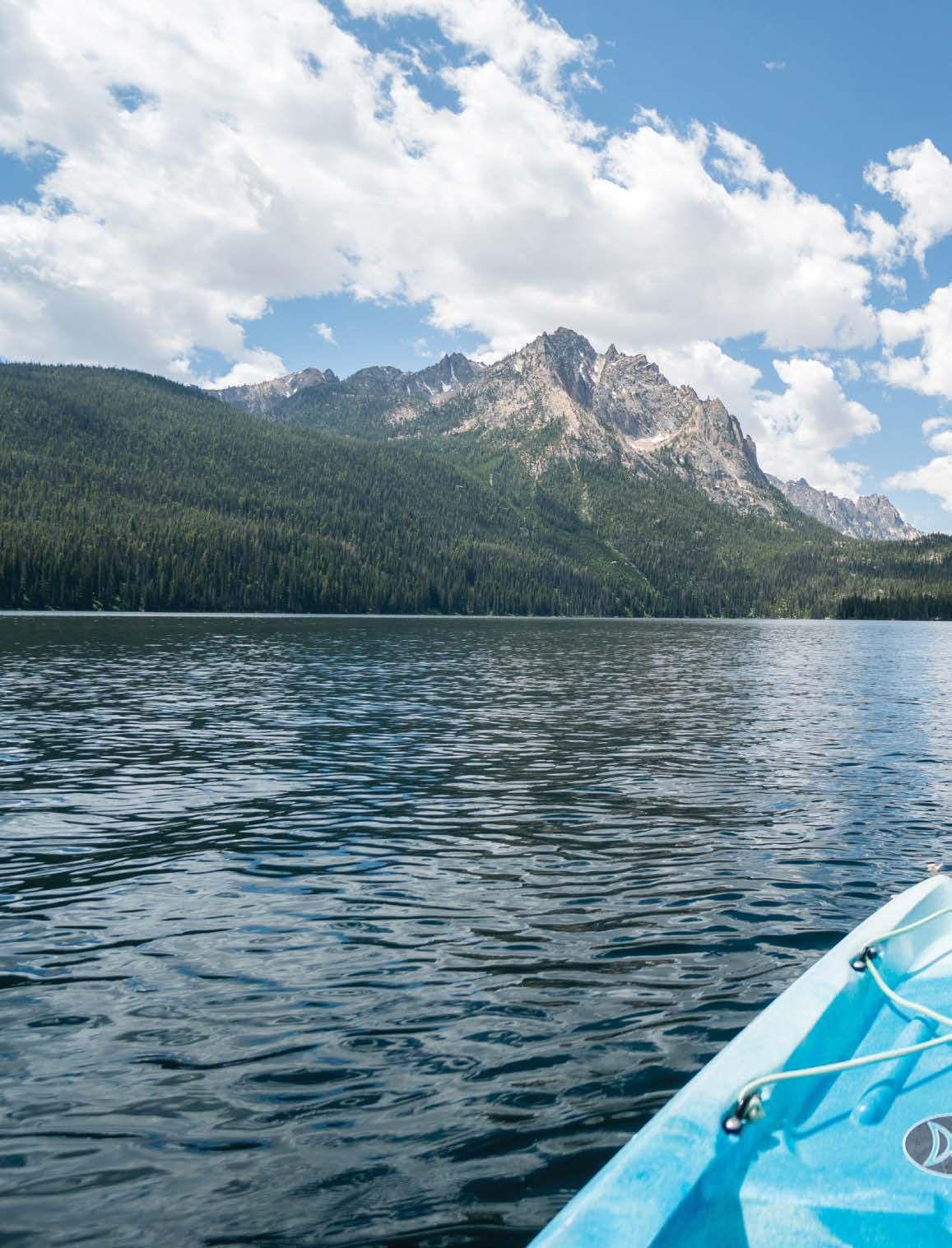 By Adam & Kathryn Frazer
By Adam & Kathryn Frazer
Before living in the Pacific Northwest, we had no idea how gorgeous the state of Idaho is! With canyons, crystal clear springs, many lakes, hot springs, sand dunes, and jaw-dropping mountains, there is so much to see and do across the state. However, one particular area has stuck with us and gained a huge spot in our hearts: the Sawtooth Mountains.
The Sawtooth Mountains are a mountain range of the Rocky Mountains in central Idaho, near the small town of Stanley. The range is home to hundreds of alpine lakes, jagged mountains that look like a saw, 50 peaks taller than 10,000 feet, nearly 350 miles of trails, and more.
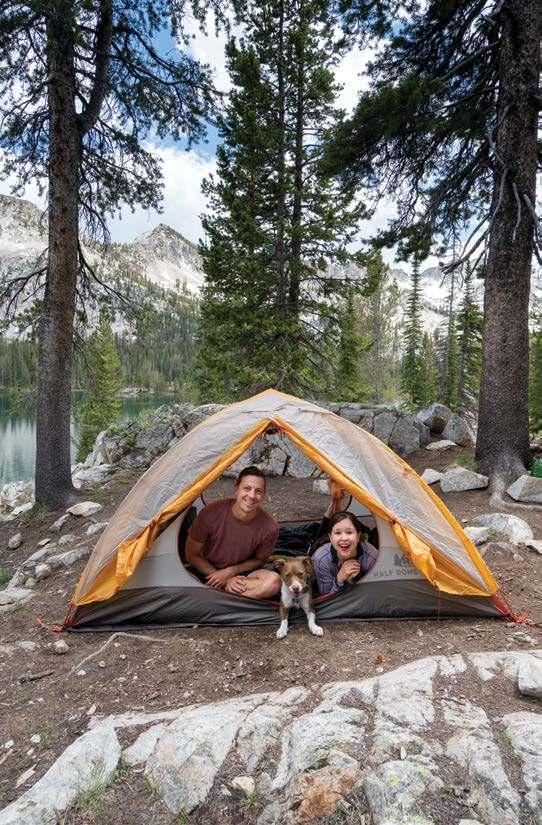

With hiking, kayaking, and hot springs, this wild paradise belongs on every adventurer’s bucket list
This past summer we spent a few days hiking, camping, and getting out on the water in the Sawtooth Mountains and fell madly in love with the area. We are often eager for our next adventure, but the Sawtooth Mountains gave us a feeling that is hard to describe. We didn’t want to leave, and we already cannot wait to go back to explore more!
But until then, we are excited to share some of our tips for visiting the Sawtooth Mountains, as well as our favorite spots, to hopefully help others experience this magical and underrated region of the United States.
Part of the beauty of the Sawtooth Mountains is how remote they are, but that does make getting to them a bit trickier.
If you’re visiting Idaho by plane, the quickest way to get to the Sawtooth Mountains is to fly into the Boise Airport, which is a scenic 2 hours and 45 minute drive from Stanley, the gateway to the Sawtooths.
If you’re road tripping around Idaho like we were, the Sawtooth Mountains’ central location makes it a relatively convenient stop no matter where you’re coming from. We visited the Sawtooths from Twin Falls, which is about 2 hours and 45 minutes south of Stanley, and it was a perfect addition to our already epic Idaho road trip!

There is very little cell service. We have both AT&T and Verizon and struggled to get service outside of Stanley and Ketchum. We had zero bars between the two cities, so make sure to plan ahead and download offline Google Maps so you can get around. We also recommend using

AllTrails Pro to download trail maps so you can view the map on hikes.
There are limited amenities. The closest city to the Sawtooth Mountains is Stanley, Idaho, which only has one small grocery store and just a handful of places to eat. We suggest stopping in Ketchum or Boise (depending on where you’re coming from) on the way to stock up on food, outdoor gear, etc.
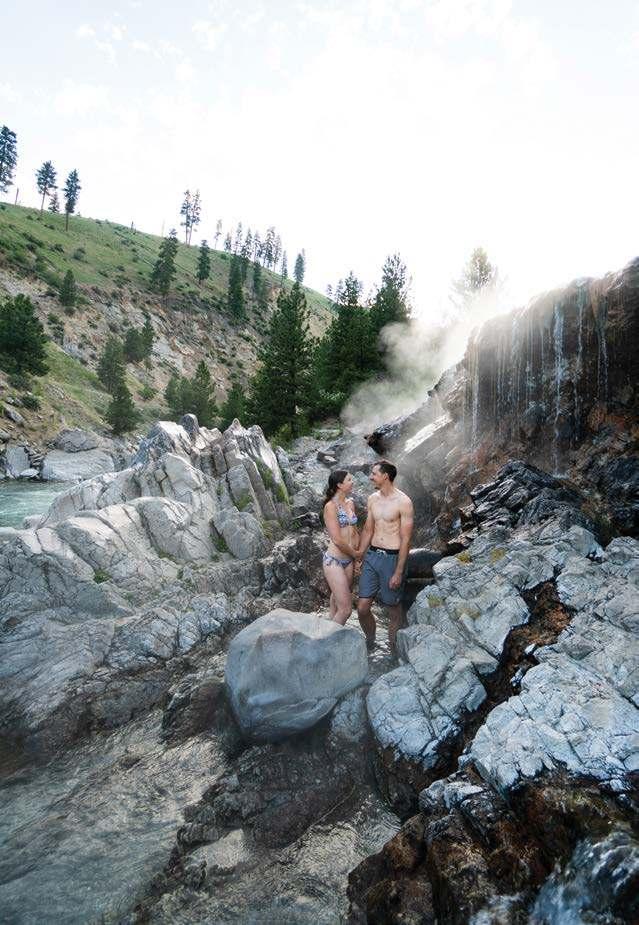

With over 350 miles of trails, there are a lot of trail options in the Sawtooth Mountains ranging in mileage and difficulty level, but all with stunning views!
During our trip, we backpacked to Alice Lake, which is 12 miles round trip. It has a gradual elevation gain, making it doable as a long day hike or an overnight trip (waking up to views of the lake is amazing!). Alice Lake has a beautiful blue color and is surrounded by the Sawtooth Mountains’ iconic jagged peaks. If you’re not too tired, we’d highly recommend hiking an extra 0.6 miles (each way) to Twin Lakes!
Another great lake hike is Sawtooth Lake, which is 10 miles round trip. Make sure you continue past the first lake, named Alpine Lake, to reach Sawtooth Lake!
For something a bit shorter, make the 8.1-mile (round trip) trek to Goat Lake, which features a waterfall and has a fun, somewhat difficult, rock scramble at the end.
Bench Lakes is another popular trail that has views of multiple lakes. There are a few ways you can complete this hike. You can either start at the Fishhook Creek Trailhead for a 7.8-mile (round trip) hike or you can take the boat shuttle across Redfish Lake.
One of our favorite things we did in the Sawtooth Mountains was kayaking on Redfish Lake! This lake is huge and has a nice beach that you can relax and swim at, a lodge with food and other amenities, clear water, and crazy mountain views.
Kayak rentals cost between $15-$20 for 1 hour, but you can rent for half a day or a full day too.
We ended up kayaking almost to the end of the lake, which was between 8 and 9 miles round trip, but the entire journey was gorgeous and made the exhaustion afterwards worth it!
They also have SUP boards, motor boats, and paddle boats to rent, as well as boat tours!
Idaho is a hot springs heaven! Before our visit to the Sawtooth Mountains, we had never soaked in hot springs and wow, we had been missing out.
There are many hot springs around the state, but there are three within a short drive from the Sawtooths.
Boat Box Hot Springs is a free hot spring located less than 10 minutes from Stanley. It’s a very unique, metal cauldron located right on the river.
The story behind this hot spring is that there used to be a large wooden box that held the hot water, which rafters would soak in after a big trip. The box kept getting damaged by floods and was finally replaced by the metal tub that is there now. The hot water comes from a tube that fills the tub with the hot spring water, but if you get too hot, there is a bucket you can use to add cold river water to the tub.
Warning: The hot spring tub is super small and can only fit 2-3 people comfortably, so arrive early so you can have it to yourself!
Mountain Village Resort, which is located in Stanley, is home to a popular hot spring pool that sits inside of a barn structure, with the doors opened for a picture-perfect view of the Sawtooth Mountains.
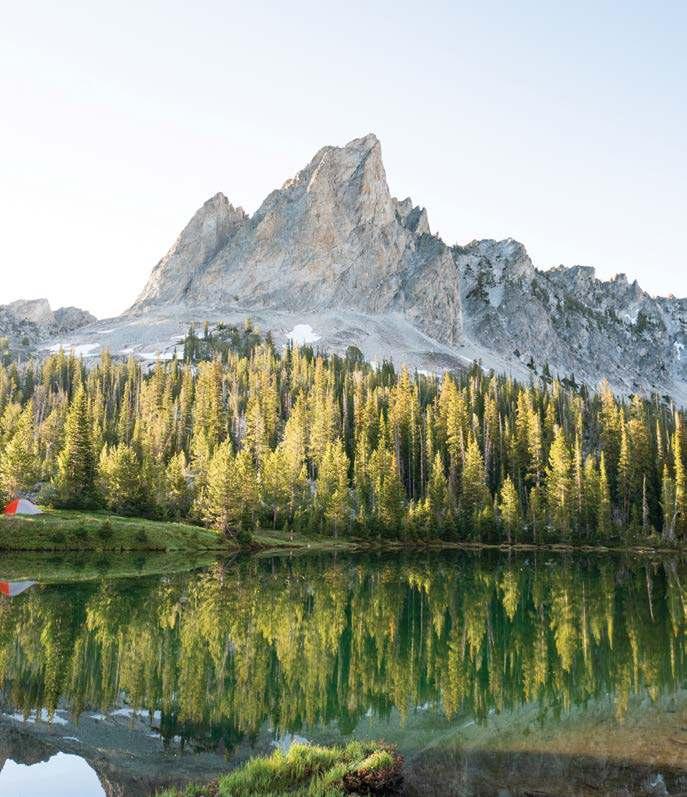
Thehotspringisfreeforguestsoftheresort, but non-resort guests will need to call to reserve a time slot and pay a fee, which we hear is around $30/hour. However, there is only one pool and private soaks are not guaranteed, so be prepared to possibly share with strangers.
Kirkham Hot Springs is about a 1-hour drive from Stanley, so while it’s technically not in the Sawtooths, it’s worth the trek! This is where we went on our hot springs adventure, and we’d highly recommend it.

There’s a $5 parking fee to access the undeveloped hot springs (free with the America the Beautiful pass!), and
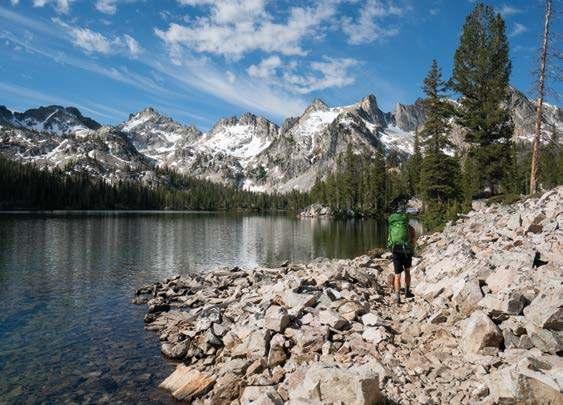
they are open from 7 a.m. to 9 p.m., although the hours may vary depending on the time of year.
After you park, it’s a quick walk down to the hot springs, which are made up of multiple pools and waterfalls right on the Payette River and surrounded by mountains. The road is nearby, however, so there will be road noise. The contrast of the bright blue and cold rushing river with the steamy pools makes for a very scenic setting.
We arrived on a Sunday right when the hot springs opened and had it all to ourselves for an hour!
Stanley is located at the foothills of the Sawtooth Mountains and is the perfect basecamp for exploring the Sawtooths! This small town with a western vibe is home to fewer than 70 people year-round. It has a handful of restaurants, a small grocery store, and a few shops to check out.

We’d suggest eating at Stanley Baking Co. & Cafeé, Papa Brunee’s, Stanley Supper Club, Sawtooth Luce’s Restaurant, and the

Sawtooth Hotel and Restaurant. And for dessert, make sure to swing by Stanley Scoops for ice cream!
Note: Most of these establishments are only open certain days of the week, so make sure to check their hours in advance!
If you’re looking for activities beyond hiking and kayaking, there are a few tour companies in Stanley that can take you fishing, horseback riding, and rafting.

One thing we loved about the Sawtooth Mountains is the abundance of free, dispersed campsites. We boondocked at Stanley Lake Dispersed one of the nights of our trip and loved it!
If you’d prefer a paid campground with a few more amenities, we’d suggest looking into Stanley Lake Campground, Glacier View Campground, Point Campground, and Sunny Gulch Campground.
For something a bit more luxurious than camping, Stanley has a handful of nice Airbnbs to choose from, as well as cabins for rent at the Triangle C Cabins and a mix of hotel rooms and cabins at Redfish Lake Lodge.
If you have yet to visit Idaho, especially the Sawtooth Mountains, add it to your U.S. bucket list immediately! With a small town vibe, barely any cell phone service,
and views as far as the eyes can see, the Sawtooth Mountains are an untouched, hidden gem. We hope you fall in love with them as much as we did.
We’re Adam, Kathryn, and Kona, an adventurous married couple (+ pup!) living on the road in our self-converted sprinter van! You can often find us driving all around the U.S. and Canada scoping out the best coffee shops, eating tacos and ice cream (we're a 5+ taco and 2+ scoop household), and enjoying nature.
To see more of our travels and our detailed travel guides, check out our website at adventuresofaplusk.com, on Instagram and YouTube at @adventuresofaplusk

In 2009, Kay Morris-Robertson did something no one else in the country was considering during a global financial crisis: She spontaneously bought an RV and decided to take the trip of a lifetime. This wasn’t going to be your average, run-of-the-mill vacation through national parks and touristy areas, though. Kay had something else in mind.


“The rules were simple,” she explained. The first rule was that she’d begin her U.S. road trip somewhere that began with the letter ‘A,’ then go to another location that began with ‘B,’ and so on until she had visited all 50 states with the 26 letters in alphabetical order. The second rule was that the locations couldn’t be a major town or city. The third rule? Well, that’s what made the trip interesting.
“The best and most important rule was that America voted where I went next, even if it was 3,000 miles in the opposite direction,” said Kay. Her followers on social media, including many Americans she met during her trip, voted online to determine her next destination. Whichever location had the most votes is where Kay would drive next. “I’ve been through Kansas probably 17 times, Oklahoma 22 times, and I’ve seen the Grand Canyon 15 times.”
In total, Kay logged over 300,000 miles and 3 sets of tires on her RV trip across America, visiting unique landscapes and small, tiny towns all along the way. Unfortunately, this
At the age of 32, Kay and her husband John moved to Los Angeles for an incredible job opportunity. Kay had grown up in Manchester before meeting John in Australia, and the couple felt they’d hit the lottery when Kay landed this dream job in the city of angels. It was a high point for them — Kay was enjoying her career and John had taken up sailing in his free time. After some training, he had Kay join him for his maiden voyage sailing the Pacific Ocean, but once they were out on the open water, his heart suddenly stopped, leaving Kay stranded on the boat with no sailing experience.
“You can imagine it was a fairly scary experience at the time,” said Kay, “and what followed next was a series of events that led to me buying an RV and traveling across America.” Going from such a high to such a low was a major, disruptive event for Kay, but sometimes hope and joy are born from tragic events.
Grieving the death of her husband, Kay threw herself into work and began having panic attacks, night terrors, and even fainting and finding herself unconscious occasionally. “Long story short, my employer freaked out, called 911, and I ended up in a mental institution for 10 days, held hostage in my Armani suit,” chuckles Kay, noting that being sent to a mental institution against her will was the least helpful thing for her employer to do in the situation. “But that led to me getting a lawyer and the help I needed.”
Professional help offered Kay the life-changing advice she needed most when they asked why she was still in Los Angeles when she could be off doing anything, anywhere
in the world. Kay nodded and took their advice to heart, immediately driving to the nearest airport and buying a ticket to a city she couldn’t even pronounce — Albuquerque.
When she arrived, she had a great weekend exploring the city, and to her astonishment she realized that she actually felt normal again. The return flight came way too soon, and while she killed time on the airplane she found a magazine in the seat compartment that advertised a trip to Bend, Oregon. She landed, booked a ticket for the following weekend, and felt even better.
“I started to realize that [while I was traveling], nobody knew me. I could be whoever I wanted, and this whole tragic story that had set me on this journey — I didn’t actually need to tell it. I could be anybody I wanted,” she said.
Kay knew that she was onto something: traveling was just what she needed to begin healing and working through her trauma — and just as importantly, she was starting to have fun. She felt like she was in her own body again, and she started to envision what an even bigger journey would look like. A for Albuquerque, B for Bend, C for … Coney Island, the next stop on her trip. But first, she’d need a different way to get there.
The very next weekend after her trip to Bend, Kay bought an RV in California, named it Reggie, outfitted it to her needs, and hit the open road. The more miles she traveled, the more her following grew online, and soon elementary schools were even getting involved in her journey as a geography experiment. Kay sent postcards to the students as they learned about different states, cities, and parks she was traveling through.
Traveling to new places and meeting new people offers a fresh perspective on life, and it was no different for Kay. There’s something exciting about stumbling on a cute new town, finding a campsite with a phenomenal view, and enjoying the freedom that comes with spending time however one wants. The open road was a tonic for Kay and for the many people that followed her journey and voted where she should go next. And the spontaneity that comes with not knowing where you’ll end up next? Kay loved it.
Doubling back on different routes across the U.S. and sticking to lots of small towns and campsites along the way makes

“You can imagine it was a fairly scary experience at the time, and what followed next was a series of events that led to me buying an RV and traveling across America.”
for a unique way to experience the country. For Kay, small towns in particular stood out along the way, like the coastal village of Ogunquit, Maine — reminiscent of the English countryside Kay calls home — and Lake Lure, North Carolina, where they filmed the movie “Dirty Dancing.”
Kay’s travels brought her from Alaska to Kawaii, Coney Island to Yellowstone. Far and away the funniest small town experience was her stop in Xenia, Illinois for the letter “X.” It’s a tiny, tiny town in the Midwest made up of a bank, a coffee shop, and a railroad. That’s it. The whole town came out to meet her and take a photo together, including the major, the bank manager, and all the other 150 residents of the town.
As for a favorite state, Kay doesn’t hesitate:“MyfavoritestatewasUtah,” she said. “I call it the screensaver state. From my experience, you drive around Utah, you pull in anywhere, and you’ll see this fantastic scenery with no one around. Then you’ll see it on a computer screensaver later and realize you were there.” Her trip ended in Zion National Park near St. George, Utah, a favorite place for travelers and hikers that love the red rocks, open country, and vast amounts of public land to boondock for long periods of time.
In a time when RV travel was mainly done by retirees, Kay’s travels proved to be an inspiration to others and a healing process for herself. She found refuge in the RV, since it allowed her to literally pull over whenever she was struggling with PTSD, find a quiet moment alone, and work through it until she felt better. And the people she met along the way only added to her healing.

As she traveled back and forth across America, people began gifting Kay with souvenirs — stickers, teddy bears, snow globes, caps, and other small items. Realizing she couldn’t part with them, Kay did what anyone would do: she covered the RV in memorabilia. One side of the RV was plastered with gifts from the east coast, the other side from the west coast, and the middle from the Midwest. Kay’s story of loss and growth, tragedy and joy struck a note with her followers — and you can experience it today by visiting her RV and the memorabilia for yourself at a museum outside Tacoma, Washington.
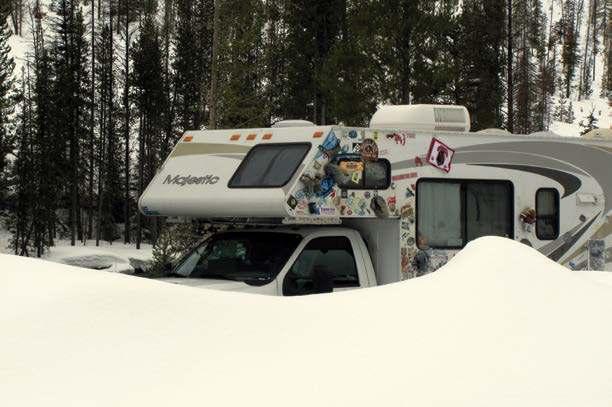
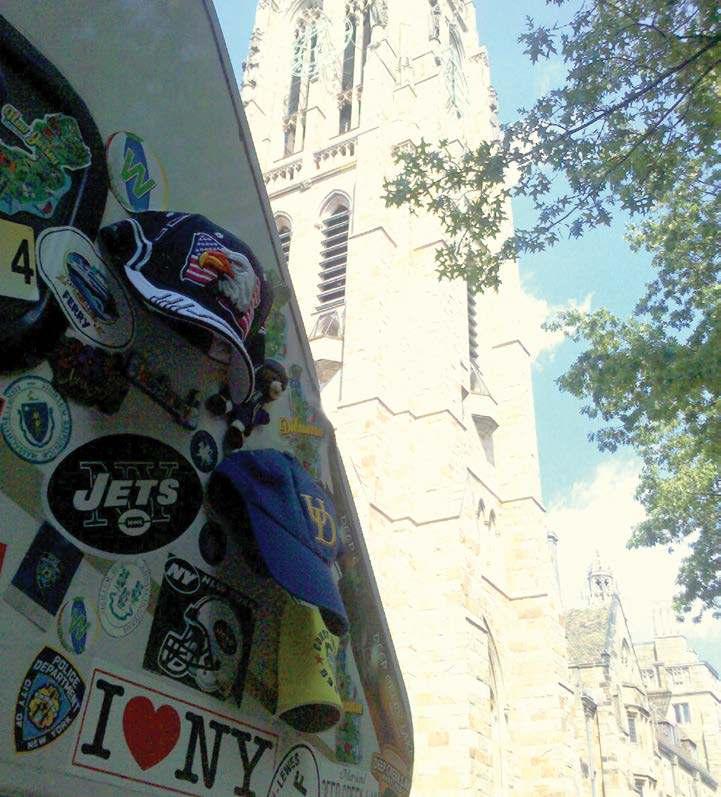
People tend to get hung up on the obstacles and fears that come with being a digital nomad, but Kay is an inspiration to all of us to throw caution to the winds, go with the flow, and take the leap to live a life outside the norm.
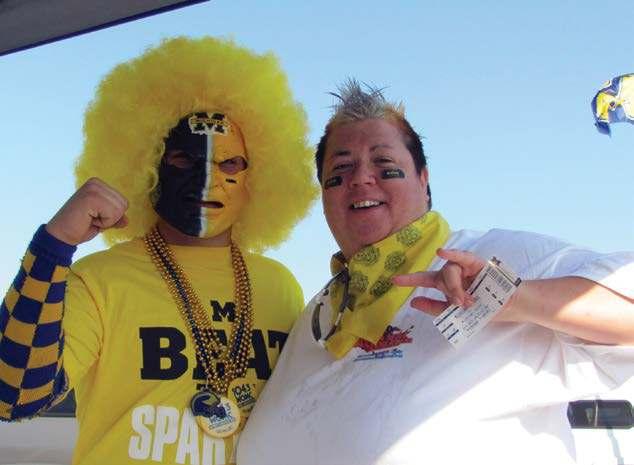

“If there’s anyone out there who’s thinking ‘that’s way too scary,’ my advice would be to just go for it.” says Kay. “You have nothing to lose.”
Traveling alone as a single female in a country she wasn’t from wasn’t just about pushing the boundaries and living outside the lines, however — it was about working through her pain and finding the joys that lie in living on the road, experiencing different places and different people. After all those miles, Kay put those hours on the road to good use. She had plenty of time to record her journey while she logged long, cross-country trips, and she wrote down all the charm of the small townsshevisitedandthemanycharacters she met along the way. When at last the trip came to an end, she compiled her notes into a travel guide named “A to Zee Across America” and donates the proceeds to charities specializing in PTSD, heart health, and bereavement.
To learn more about Kay’s personal story, however, you’ll have to wait to see it on the big screen: Kay’s story is currently in pre-production with a film company that will bring the story of her journey across America to theaters. Visit AtoZeeAcrossAmerica.com for more on Kay’s adventures and to grab her book A to Zee Across America on Amazon.



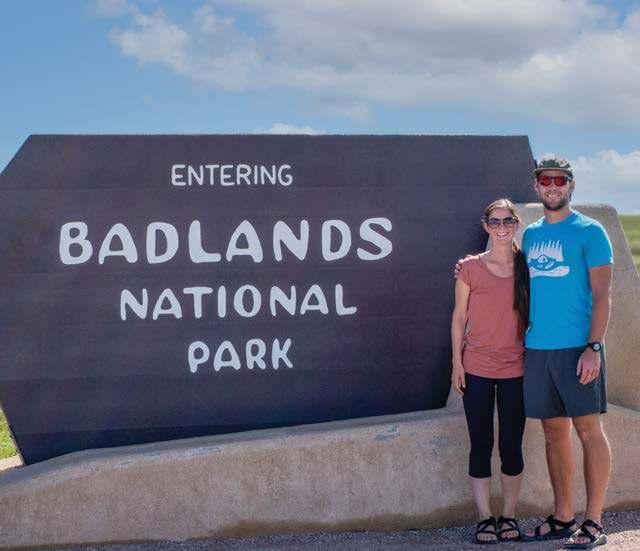

Don't let the name fool you — there's nothing bad about this national park!
By Isak KvamWe spent days driving our van through nothing but flat prairies and occasional hills when the horizon disappeared. The sun was setting in western South Dakota, the warm summer breeze blew lazily through tall grass, and suddenly the flat landscape gave way to a huge vista of rugged badland features.
Don't let the name fool you — Badlands National Park is full of jagged canyons, stunning buttes, and colorful sandy formations. And with a handful of great day hikes and a great campground view of the badland features, it's a park for digital nomads.

Badlands National Park was the very first destination my partner Maria and I chose to start our digital nomad lifestyle. We had spent the previous two years shopping for the perfect cargo van, learning how to convert it ourselves, and transitioning our lives to be remotefriendly for a life of freedom and intentionality.
Our time in Badlands was filled with the joys that face every new digital nomad when they first hit the road: an immense feeling of freedom to do what you want when you want and a healthy dose of disbelief that this was actually the lifestyle we got to enjoy after years of planning and working toward it.
It was also filled with less-than-glamorous realities that newbies to the road have to learn: how frustrating it is to find cell service, how to park your rig in high winds so you don't wake with each gust of wind, and of course learning to live with another person in a tiny, tiny space.

Badlands National Park holds a special spot in
our memory since it was the first stop during the honeymoon phase of our vanlife journey — but don't worry, no matter what stage of digital nomad journey you're on, Badlands won't disappoint.
Park visitors can usually look forward to a handful of wildlife sightings — a bison, some prairie dogs, and maybe even a herd of bighorn sheep. We were granted all 3 within five minutes of entering the park.
We first spotted a 2,000-lb. bison grazing in the ditch just past the Pinnacles Entrance Station with its head down, and thankfully uninterested in our big white van, we slowly passed it. Capable of running up to 35 mph, these strong behemoths are an animal you want to keep your distance from.
We drove along Sage Creek Rim Road, which gave way to a gorgeous overlook of the sandy badland features that give the park its name. Pretty quickly we spotted a herd of bighorn sheep posing and resting on the badland features.
A little further down the road, we parked at the Roberts Prairie Dog Town and couldn't help but chuckle at the littleprairiedogspokingtheirheadsabovetheirtunnels. Visitors of all ages were smiling at their warning calls to approaching visitors while they bobbed their heads up and down.
Sage Creek Rim Road is a tamer area of the park. There's flat, tall-grass prairie to the north and a great overlook of the badlands wilderness area to the south as the road turns to wash boarded gravel on the way
to the free Sage Creek Campground. We parked here during our stay and were delighted to find another prairie dog town, this one right in the middle circle of the campground itself. Every morning, folks would drink coffee outside their vans, tents, and RVs to watch the prairie dogs bounce up and down.
The iconic park section is the Cedar Pass area, including the year-round Cedar Pass Campground with 96 sites

and a great view of the badlands. The Ben Reifel Visitor Center is nearby, with exhibits on the park's geology and history, a working fossil preparation lab, and a park bookstore to get all the stickers and Badlands merch you need.
Driving the Badlands Loop Road is a "must-do," with its many overlooks of badland formations which make for great photo opportunities. We highly recommend catching a sunrise from Big Badlands Overlook in the east section of the park. The rising sun lights up the red and dark-gray stripes in the sandy badland features in a way the midday sun can never quite compete with.
As for hiking, the Saddle Pass Trail offers a great challenge. The onehour hike quickly gains in elevation as you climb up the Badlands Wall. Once you get to the top, you can loop through Castle and Medicine Root Trails to weave through flat prairie — you'll enjoy the break before you head back down!
For a shorter hike, take the Notch Trail through a meandering canyon, up a dramatic view up a rope ladder (snap a photo!), and over to a great view of the flat prairie below the badlands. The rope ladder isn't as steep as it's often photographed — but at the top you can point your phone down the ladder top for a more dramatic angle.

With plenty of trails to hike near the campgrounds and some pretty remote backcountry hikes available in the lessaccessible areas of the park, Badlands definitely earns a spot on your next trip through the area, whether you're in the honeymoon stage of your journey or not.

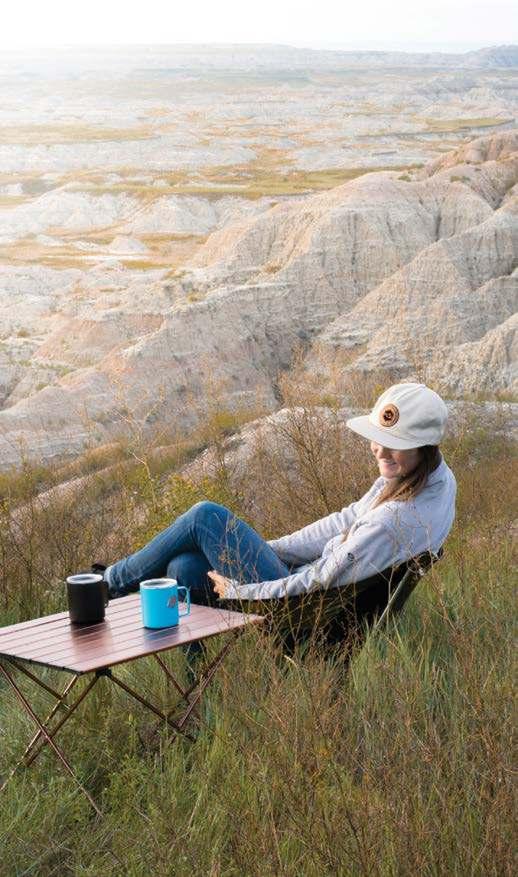
Badlands National Park Info
Size: 242,756 acres
Location: Western South Dakota
Best For: Camping, hiking, scenic drives, panoramic views
Where to Stay: Cedar Pass Campground has the best views and is closest to the most iconic views and trails in the park. Sage Creek Campground is more remote and free on a first-come, first-served basis, but the half-hour drive along Sage Creek Rim Road can get wash boarded and muddy, there are fewer badland formations in the area, and there's no cell service. Boondocking at Badlands Overlook in Buffalo Gap National Grassland just five minutes north of the Pinnacles Entrance has great views of badland features and has decent service — the perfect blend for digital nomads. Always check local regulations and follow Leave No Trace guidelines.
Small Adventures: Drive the scenic Badlands Loop Road (1-2 hours). Hike the Notch Trail (1.5 miles, moderatestrenuous). Hike the Door Trail (0.75 miles, easy, boardwalk) and Window Trail (0.25 miles, easy). Visit the Fossil Preparation Lab at Ben Reifel Visitor Center.
Big Adventures: Hike Castle Trail (10 miles, moderate) from the Door and Window parking area, and consider looping it with Medicine Root Loop (4 miles, moderate). Alternatively, start your hike at Saddle Pass (0.25 miles, strenuous) and loop through Castle Trail & Medicine Root Loop. Drive the perimeter South Unit of the Badlands (1-2 hours) or the Sage Creek Rim Road (1-2 hours).
Nearby Points of Interest: The town of Wall, S.D. is 7.5 miles from the park and is home to the famous Wall Drug. The nearby Minuteman Missile National Historic Museum stored nuclear missiles during the Cold War. When you're ready to leave, consider nearby Wind Cave National Park (62 miles away), Custer State Park (69 miles away), Sturgis and Deadwood (87 miles away), and Devils Tower (165 miles away).
Isak is an entrepreneur and freelance outdoor writer. He travels full-time through western public lands with his girlfriend Maria in their self-converted van. They left their traditional life in Minnesota to live intentionally and grow their business Seek More Wilderness, which provides outdoor lifestyle apparel that defends the wild. When they’re not advocating for public lands, you can find them downhill skiing, housesitting in mountain towns, or scoping out the local coffee shops. Follow them on Instagram @IsakandMaria and shop the brand @SeekMoreWilderness at SeekMoreWilderness.com.

You never know what you might get when you start following random GPS coordinates. Sometimes you end up in a cramped parking lot, after wading through potholes the size of the Grand Canyon, and other times you find yourself in the middle of scenery that seems to be hand-picked from a movie.
Sublett Reservoir, settled in the Sawtooth Mountains of Idaho, was a truly incredible boondocking experience. After driving for miles down a gravel road with no cell service, hoping the GPS coordinates worked, we entered into a truly heavenly space! Surrounded by gorgeous, green mountains on all sides we felt like we were in a scene from The Sound of Music and couldn't stop singing "The hills are alive..."
We had the entire place to ourselves and soaked in as much of the beauty as we could in one night! The allowable length of stay is 14 days and if we could have stayed the entire time we would have, but working from the road means a need for reliable service. Sublett Reservoir is better reserved for when you are truly able to unplug.
With hiking options, back roads to explore, and the reservoir to
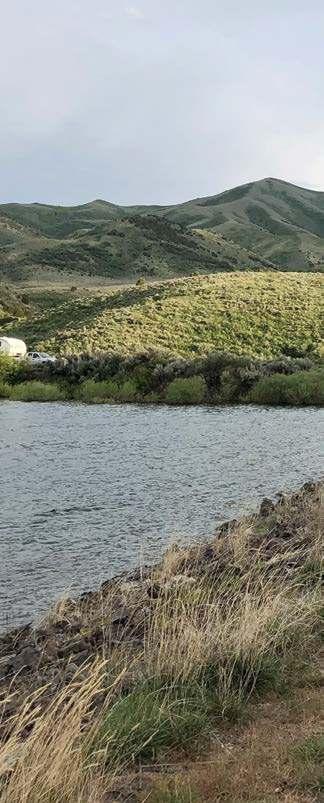
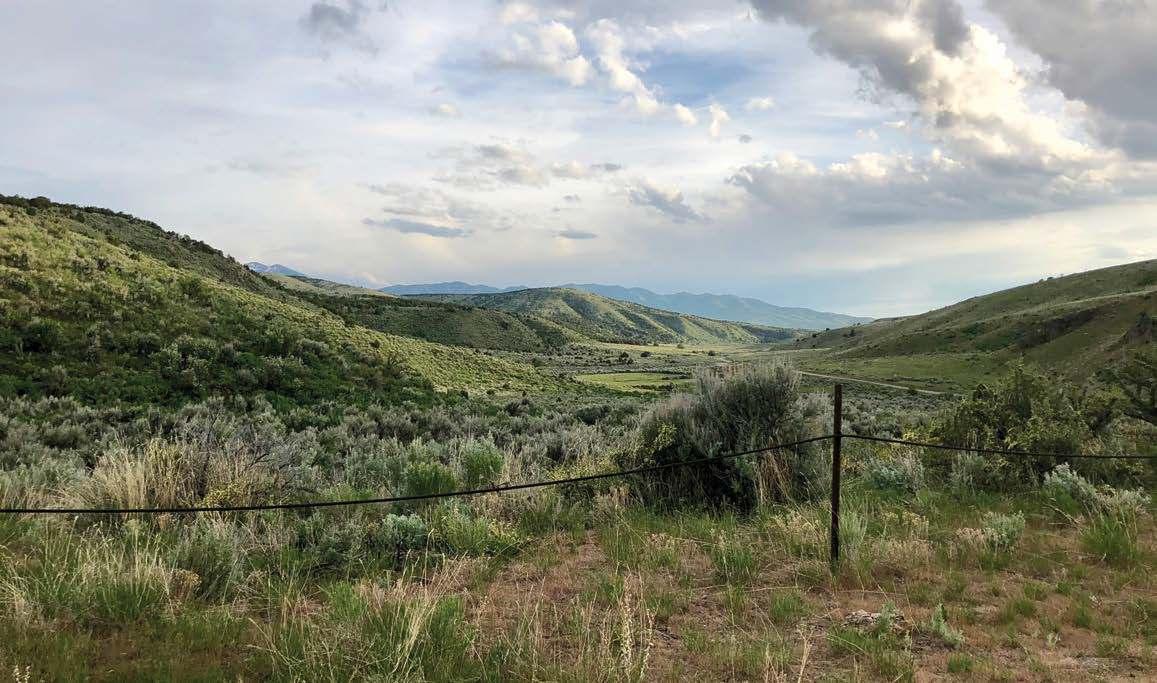
fish in you won't be at a loss for ways to fill your day! There are many different options for places to set up camp, but we would recommend the gravel lot off to the right when first pulling up to the reservoir. Though the road over the levee is a bit tight, we had no problem pulling our 34ft fifth wheel down to the graded dirt lot. There are primitive toilets available if needed and you can park right along the water's edge.
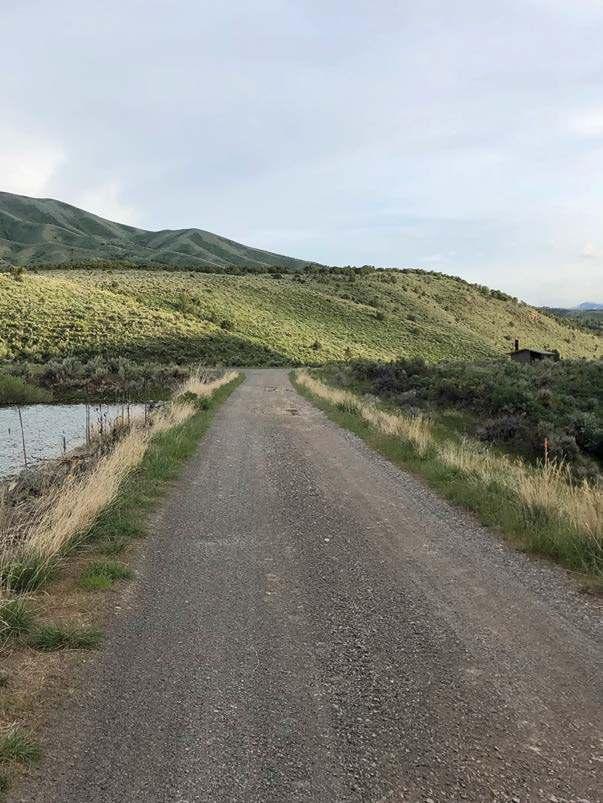
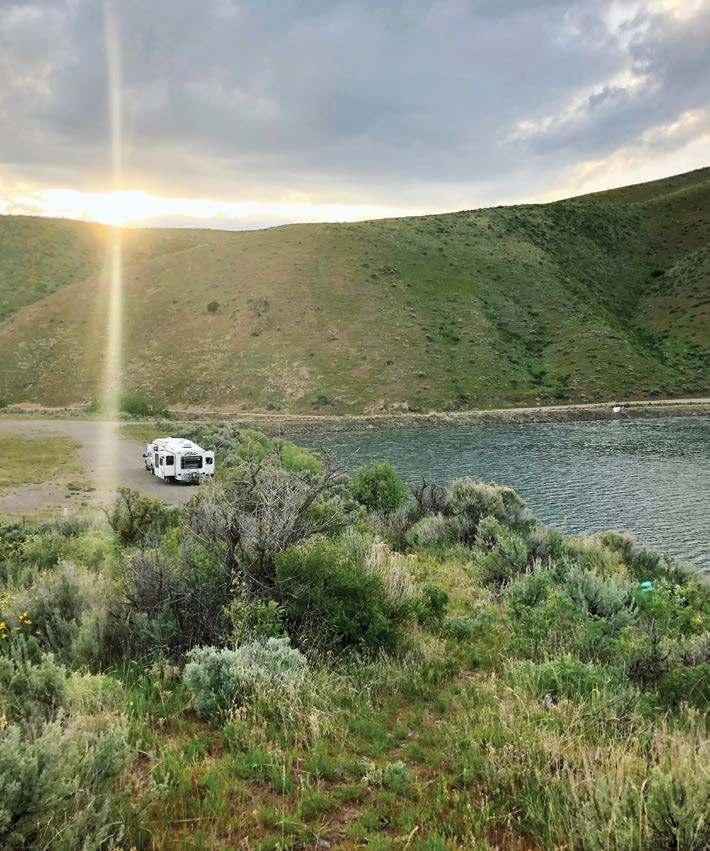
We would recommend going midweek if possible to secure your pick of front-porch views before the weekend crowd comes in to fish. There are spots further into the reservoir if you choose to keep going, but they are better suited for those with small rigs, truck campers or tents. Spots are also available down by Sublett Creek before you get to the road that leads to the gravel lot, which can accommodate larger rigs and offer a bit more privacy. One of the places we most want to revisit, Sublett Reservoir is a gem that should not be missed.
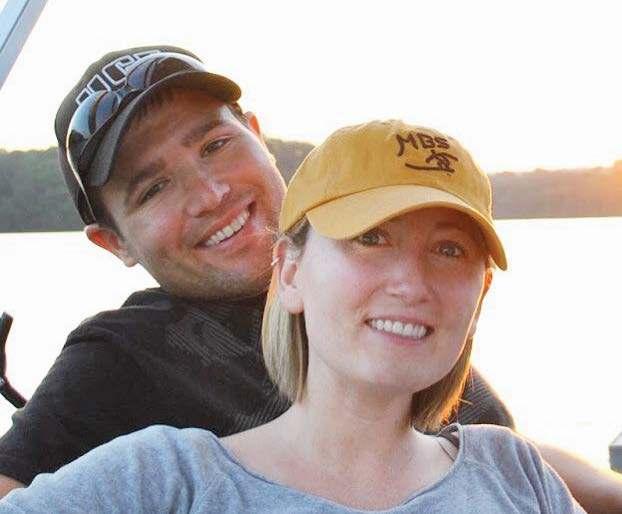

Want to hold a small food party at home? Iconites air fryer is your best choice. It has extra large 7QT nonstick basket, which can provides enough space to cook food for 2-9 people at one time. Cooks by 360°circulatinghotair,whichofferscrunchy food with little to no oil!

1080p HD video doorbell with enhanced features that let you see, hear, and speak to anyone from your phone, tablet, or PC. An upgrade from the original Ring Video Doorbell 2, enjoy improved motion detection, privacy zones and audio privacy, and dual-band (2.4 or 5.0 GHz) wifi connectivity. Exclusive to Ring Video Doorbell 3 Plus, get 4 extra seconds of black and white video to show you what happened before motion was triggered with Pre-Roll.
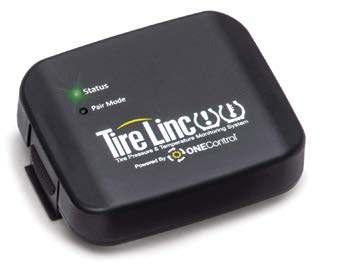

Sensorsupdatepressureandtemperature several times each minute while your RV is moving and check every 15 minutes while parked. Plus, sensors notify you any time the tires inflate, deflate, or in the case of a blowout.
Reinforced ratchet gear head constructed from hardened, heat treated Chrome Vanadium alloy steel. Rust & corrosion protection with unique and newly invented Electro-Black finish treatment. Features an easy-to-read, dual-range scale. Identify the markings even in low-light conditions.
Delivers jump-starting power with 700 peak amps and 350 instant starting amps.Featuresa120PSIaircompressor to help inflate tires with low pressure; High-powered LED light rotates 270 degrees to help you work in the dark
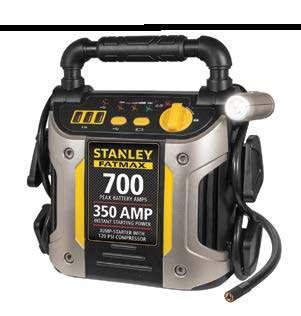

Place in front or behind tires for traction. Designed to hold in place and won't fly out. Works in snow, mud, and sand.
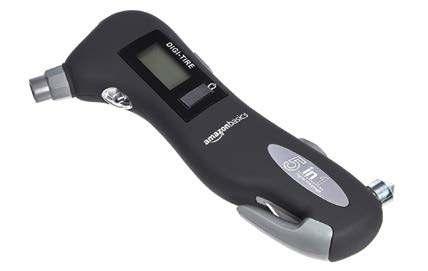
With LED flashlight and LCD backlight for quick, easy tire-pressure readings, even in dim light. Pressure range from 3-150 PSI with a high level of accuracy (+/-1 PSI). Includes emergency escape tools, including a window hammer and a seat belt cutter.


Easy & Quick Installation: Most RVs are already prepped for the Vision S sharkfin camera system, eliminating extensive drilling requirements. Waterproof Camera with Night Vision. Comes with 1 High Resolution (720x480) IP65 waterproof camera with infrared night vision, live streaming, intelligent IR cut filters and wide viewing angle of 120°.
Generous storage capacity of 36L to fit 50 cans. Heavy-duty yet lightweight ExoFrame construction with fender frame protected edges and aluminum alloy handles. Powerful VMSO3 compressor cooling technology efficiently refrigerates and deepfreezes to –7 °F.
PORTABLE CAT DOG CRATE
Collapsible design makes it easy to carry, unfold and fold.Perfectfortravel,outdoorandindoortransitions. Light weight carrying case make it easy for travel or camping trips.
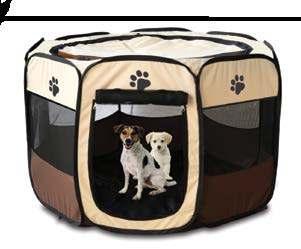
Cat Carroll
Presley Gossett
Jamie Rea
Isak Kvam
Rae Miller
Erika Hernandez
Ryan Fullerton
Hilary Bird
Patty Gill
Renee Hayes
Steve & Erika Puvalowski
Tracie Shroyer
Scott Johnson
Taylor Cluster
Alexis Nascimento
Adam & Kathryn Frazer
Kay Morris-Robertson
Melanie & Andrew Snavely
Rootless Living Magazine

Volume 2 | Issue 8 | March/April 2021
Publisher Demian Ross
Editor Nikki Kirk
Copy Editor Isak Kvam
Advertising Information: sales@rootlessliving.com



ROOTLESS LIVING • 3916 N POTSDAM AVE #3194, SIOUX FALLS, SD 57104
Disclaimer: One of the great things about digital publications is the ability to link you directly to the products or services you want to hear more about. Some of the links in this issue are affiliate links where we earn commissions on goods or services you buy. These commissions help us to continue to publish the magazine. Rootless Living is also a participant in the Amazon Services LLC Associates Program, an affiliate advertising program designed to provide a means for sites to earn advertising fees by advertising and linking to Amazon.com. If you have any questions please don’t hesitate to reach out to us at info@rootlessliving.com
Nothing compares to a local’s perspective and that’s precisely what Cindy Scott wants to show you.
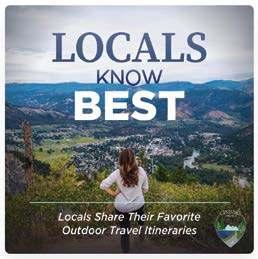

Alvin Hall and Janée Woods Weber drive from Detroit to New Orleans collecting powerful personal testimony about how Black Americans used the historical travel guide during the height of segregation.

This is what adventure sounds like. Climb. Ski. Hike. Bike. Paddle. Run. Travel. Whatever your passion, we are all dirtbags.
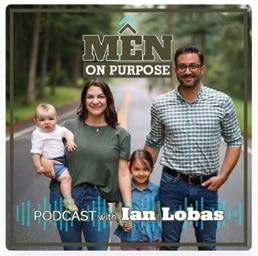
The show that spotlights, celebrates, and elevates the arising model of men who are visionary, compassionate, and freely expressing themselves in their own highest purpose.

Want the best books broken down into small bite sized pieces? Welcome to Mind Your Helm.

An exploration of the weird, strange, unusual, and fascinating phenomena in the physical world around us.

Bringing you the daily realities of life inside prison shared by those living it, and stories from the outside, postincarceration.

Helping you take your brain health to the next level and teaching you how to live your best life!
Podcasts are listed as a courtesy to our readers and compiled from recommendations in various Facebook groups. If you have a podcast you think we should include, email us at info@rootlessliving.com





Our Service Response Team consists of eight expert techs with trucks and trailers spread out across the US. They are committed to training dealer technicians to aid in getting you in and out of appointments. The team is trained to assist anyone stuck on the side of the road in need. You don't have to be a part of the Grand Design Family to receive our helping hand. In times like these, we need to show all RV'ers that Grand Design cares about them even if they didn't choose our products as their home away from home.
